What is living?
- Books Name
- AACHARYA KOTA CLASSES Biology Book
- Publication
- AACHARYA KOTA CLASSES
- Course
- CBSE Class 11
- Subject
- Biology
ggyyuyuyu
What is living?
- Books Name
- ACME SMART COACHING Biology Book
- Publication
- ACME SMART PUBLICATION
- Course
- CBSE Class 11
- Subject
- Biology
WHAT IS LIVING?
Life is a unique, complex organisation of molecules expressing itself through chemical reactions (metabolism) which lead to growth, development, responsiveness, adaptation and reproduction. Hence, "the object by itself exhibiting the growth, development, death, consciousness, reproduction etc. is designated as living being."
A. Characteristics of Living Beings
All the living beings share certain unique and basic characteristics which set them apart from non-living objects. These characteristics are listed below :
1. Growth
2. Reproduction
3. Metabolism
4. Cellular structure
5. Consciousness
1. Growth:
Increase in mass and increase in number of cells are twin characters of growth. Growth refers to irreversible increase in mass or overall size of a tissue, an organism or its parts.
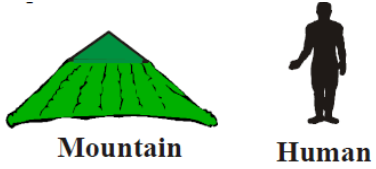
Growth is the result of difference between anabolism (building up reactions) and catabolism (breakdown reactions).
Growth occurs when anabolism or synthetic processes exceeds catabolism.
Degrowth or negative growth will occur when catabolism exceeds anabolism. It will decrease the mass of body.
Unicellular organisms also grow by cell division. In majority of higher animals and plants, growth and reproduction are mutually exclusive events, but in unicelled organisms like Amoeba, reproduction is synonymous with growth, i.e., increase in number of cells.
Non-living objects also grow if we take increase in body mass as a criterion of growth. But in these objects extrinsic growth is present i.e. increase in the mass of body from outside e.g., mountains, boulders and sand mounds. Growth, therefore, cannot be taken as a defining property of living organisms.
2. Reproduction:
Reproduction is the formation of new individuals of similar kind. It is, however, required for survival of the population as it compensates for the loss of life due to death.
Reproduction is of two types, asexual and sexual. Asexual reproduction is uniparental multiplication that occurs through binary fission, multiple fission, spore formation, fragmentation and vegetative multiplication.
Fungi multiply by asexual spores, yeast and Hydra show budding, Planaria exhibits true regeneration. Fungi, filamentous algae, protonema of mosses easily multiplies by fragmentation. But, when we notice single-celled organisms like bacteria, unicellular alga and Amoeba, we are not clear about the usage of these two terms -growth and reproduction, i.e., increase in number of cells.
Hence, reproduction also cannot be an all inclusive property of living organisms. Still, no non-living object is capable of reproducing or replicating by itself. Further, there are some organisms which do not reproduce at all, e.g., worker bees, mules etc.
3. Metabolism:

Life is a never ending flow of energy and materials.
The energy are required by all living cells for building and functioning of their living matter.
Metabolism is the sum total of all chemical reactions occurring in an organism due to specific interactions amongst different types of molecules within the interior of cells.
Metabolism involves exchange of matter and energy between an organism and its environment and transformation of matter and energy within an organism.
Despite vast differences occurring in structure and functioning of cells in different organisms, metabolic reactions are unusually similar.
Metabolic reactions can be demonstrated outside the body in cell free systems.
An isolated metabolic reaction(s) in a test-tube is neither living nor non-living. Hence, while metabolism is a defining feature of all living organisms without exception , isolated metabolic reactions in-vitro are not living things but surely living reactions.
An isolated metabolic reaction(s) in a test-tube is neither living nor non-living. Hence, while metabolism is a defining feature of all living organisms without exception , isolated metabolic reactions in-vitro are not living things but surely living reactions.
4. Cellular structure:
Body of all living organisms consists of cells and their products. Hence, cellular organisation of the body is the defining feature of life forms.
5. Consciousness:
All living beings, plants and animals, are aware of their environment. All organisms sense their surroundings and respond to sudden or smooth changes in it.
All organisms from prokaryota to eukaryota can sense and respond.
Humans also have "self-consciousness" hence, this becomes the defining property of living beings.
It is most obvious and technically complicated feature of all living organisms.
The foregoing discussion, nevertheless concludes that living beings are organized, self-replicating, evolving and self-regulating interactive systems, with consciousness at the head of all.
A question may arise whether a man lying in coma on the life support systems is living or non-living? The answer lies in the quantitative presence of consciousness in the living being in that particular state. Infact, the person in coma has lost the requisite quantity of consciousness to exhibit the features of living being, but still exhibits life. If the requisite consciousness is restored, the person may again start to be as living being or die otherwise.
Other characteristics of living beings are adaptation, life span, homeostasis, healing and repair, movement and variation.
Biodiversity
From a current estimation, approximately 1.7 million species have been scientifically named and classified. These include nearly 1.2 million animals and over 0.5 million species of plants.
Amongst animals, insects form the largest group, i.e., over 10,25,000 species. It is estimated that majority of species diversity is confined to tropical rain forests and huge diversity exist in under water reef formations in tropical oceans.
Existing living species are the outcome of about 3.5 billion years of evolutionary process on this earth. Nearly 15,000 new organisms are discovered every year.
A clearer understanding of this huge variety of organisms can be studied by dividing these into smaller groups or sub-groups (categories) and each group or sub-group comprising of organisms with more or less similar characters.
Method of placing organisms into groups or sub-groups depending upon extent of similarities and differences is called classification.
The division of organisms into different groups follows certain rules, that is why the term called taxonomy is used for classification of organisms following certain rules or principles.
Need for classification
There are millions of plants and animals varying greatly in their form, structure and complexity.
It is impossible to study all of them individually. To make the study of organisms possible and easier, scientists have divided organisms into different ranks or categories on the basis of similarities and differences.
Classification is just like systematically arranged library where we can easily find out the required book, in the same way, if the organisms are arranged according to a system, it makes their study easy.
Some important needs are
It is essential to understand the inter-relationship among different groups of organisms.
It serves as a base for the development of other biological sciences like biogeography.
Various applied biology fields also depend upon exact identification and classification.
Taxonomy and Systematics
Taxonomy: The branch of science dealing with the study of principles and procedures of classification is called taxonomy. The term taxonomy was coined by A.P. de Candolle. Linnaeus is considered as Father of Taxonomy. Santapau is considered as Father of Indian Taxonomy. The fundamental elements of taxonomy are as follows :
- Characterisation and identification : It is the determination of the similarities of an organism with an already known organism, based upon specific characters.
- Nomenclature: It is the determination of correct name of an organism according to established universal rules.
- Classification: It is grouping of organisms into convenient categories on the basis of easily observable characters.
-
The classical taxonomy is based on observable morphological characters, however the modern taxonomy deals with several characters for the classification of organisms like
(a) External and internal structure alongwith the structure of cell.
(b) Development process.
(c) Ecological information of organisms
Systematics : The word "systematics" is derived from Latin word systema which means systematic arrangement of organisms. It was first used by Carolus Linnaeus. According to him, "systematics is the discipline of biology which deals with the kind and diversity of all organisms and the existing relationships amongst them."
Generally, the terms such as classification, systematics and taxonomy are used interchangeably but some taxonomists like Simpson (1961) relate them with a separate field. He defined systematics as
"The study of diversity of organisms and all their comparative and evolutionary relationships based on comparative anatomy, comparative ecology, comparative physiology and comparative biochemistry."
The main uses of systematics are as given below :
(i) It helps in providing knowledge of great diversity of animals and plants. It provides information regarding evolution which took place among plants and animals by knowing the distinction, relationship, habitat and habits. It thus, gives a vivid picture of entire organic diversity.
(ii) It helps in the identification of fossils which gives useful information about the phylogeny of organisms.
(iii) Newly discovered organisms can be identified through systematics. well as the specimens
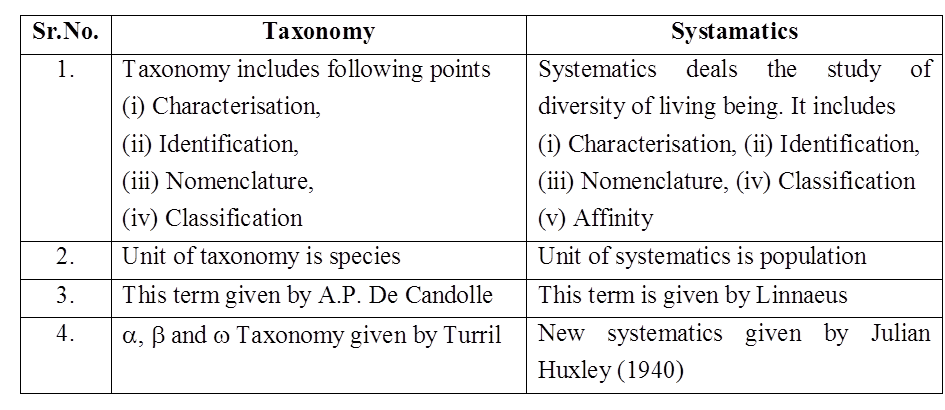
Concept Builder
1. The reasons for large scale biodiversity amongst living beings are :
-
- Adaptations in organisms to diverse habitat in order to reduce competition.
- Change in genetic constitution.
- Isolation
2. Ontogeny is the life history of organisms. Phylogeny is the evolutionary history of organisms.
3. Systematics is taxonomy alongwith phylogeny.
4. Classical or old or descriptive systematics is based upon morphological characters. According to it basic unit of classification is species. Pioneer workers are Aristotle and linnaeus.
5. New systematics / Biosystematics / Neosystematics is based upon all characters" i.e., morphological, cytological, ecological, biochemical, genetical etc. The term was coined by Julian Huxley. Basic unit of classification is population or sub-species for the new systematics.
6. Founder of taxonomy / Father of biology / Zoology–Aristotle, Father of Botany –Theophrastus, Father of Indian Botany/Indian herbaria -William Rouxburgh.
7. About 5-30 million species of living organisms exist today. Taxonomically or scientifically known number of species is 1.7 million or 13 percent.

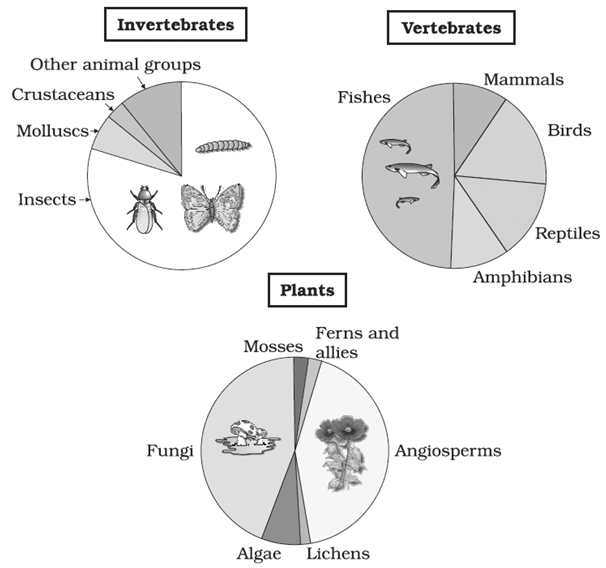
Representing global biodiversity: proportionate number of species of major taxa of plants, invertebrates and vertebrates
What is living?
The dog I can hear barking is alive, and so is the tree outside my window. However, snow falling from the clouds is not alive. The computer you’re using to read this article is not alive, and neither is a chair or table.
What is living?
Anything which shows characteristics of life is called living. The fundamental characteristics of life are- growth, reproduction, metabolism, cellular organization and consciousness. Living things are highly organized, meaning they contain specialized, coordinated parts.
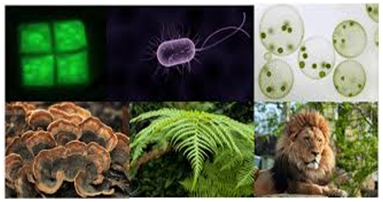
Growth
Living things tend to grow in size. The increase in the number and mass of individuals are two unique characteristics of growth. Multicellular organisms exhibit growth by cell division. Growth varies in plants and animals. If we consider unicellular organisms, they tend to grow in size by cell division. Moreover, this can be easily detected by counting the cells during in vitro cultures under a microscope.
Reproduction
Reproduction is the process by which organisms replicate themselves.
Reproduction can primarily be of two types- sexual reproduction and asexual reproduction.
Reproduction generally refers to sexual reproduction. Asexual reproduction is used by the lower organisms like Bacteria that divide asexually via Binary fission, Virusestake control of host cells to produce more viruses; Hydras (invertebrates of the order Hydroidea) and Yeast are able to reproduce by Budding.
Sexual reproduction is a biological process that creates a new organism by combining the genetic material of two organisms in a process that starts with, meiosis a specialized type of Cell division
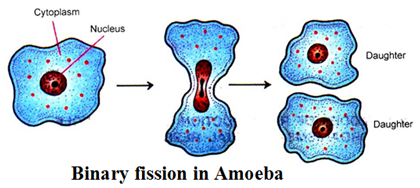
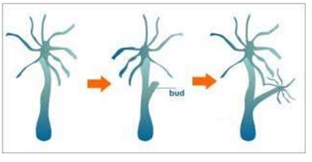
Metabolism
Metabolism is the sum of the chemical reaction that takes place within each cell of a living organism and that provides energy for vital processes and for synthesizing new organic material.
All living organisms are made up of chemicals. These chemicals, small and big belonging to various classes, size and function, etc are constantly being made and changed into other biomolecules.
There are thousands of metabolic reactions occurring simultaneously inside all living organisms, be they unicellular or multicellular.
Cellular organization
Cellular organization – All living organisms are made up of cells that perform all functions inside the body. The cellular organization is the components that make up the cell and how they are arranged inside it. Each component called an organelle, performs a specific function vital for the cell.
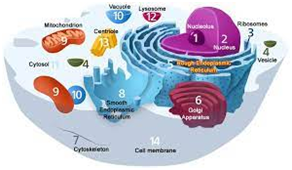
Consciousness
All living organisms have an inherent ability to sense their surroundings or environment and respond to their environmental stimuli which could be physical, chemical, or biological. Plants and animals both respond to external stimuli. Human beings are the only organisms who are aware of themselves, i.e., have self-consciousness.
What is living?
Chapter 1
The living world
What is living?
Biology is the study of biological organisms and processes. There is an incredible diversity of living organisms around the globe. Any system capable of executing processes including feeding, metabolizing, excreting, breathing, moving, growing, reproducing, and responding to external stimuli is characterized as living. Living refers to anything that exhibits the attributes of life. Growth, reproduction, metabolism, cellular organization, and consciousness are the basic features of life. On the other hand, self-consciousness is seen as the defining quality of living organisms. Let us take a detailed look at all the unique features of living organisms.
(A) Growth:
Growing is a process that occurs in all living creatures. The twin features of growth are an increase in bulk and an increase in the number of individuals. Cell division is a process that enables a multicellular organism to grow. Plants grow by the division of cells constantly throughout their lives. This growth is only visible in animals up to a particular age. Cell division, on the other hand, happens in some tissues to replace lost cells. Cell division is responsible for the growth of unicellular creatures. Growth and reproduction are mutually exclusive phenomena in the majority of higher animals and plants. It's important to note that growth is defined as a rise in bodily mass.
If we use body mass as a criterion for growth, non-living objects grow as well. Mountains, boulders, and sand mounds are all formed through erosion. Non-living objects, on the other hand, demonstrate this type of growth by accumulating material on the surface. Growth occurs from the inside out in living organisms. As a result, growth cannot be considered the only distinguishing characteristic of living beings. It must be described under what conditions it can be observed in all live species before we can grasp that it is a property of living systems. A dead creature can’t grow.
(B) Reproduction:
In multicellular organisms, reproduction refers to the generation of offspring with characteristics that are comparable to those of their parents. It refers to sexual reproduction invariably and implicitly. Asexual reproduction is also used by living species. Fungi, for example, can quickly proliferate and spread because they produce millions of asexual spores. We see budding in smaller species like yeast and hydra. True regeneration is observed in Planaria (flatworms), in which a fractured organism regenerates the missing section of its body and transforms into a new creature. Filamentous algae and moss protonema may all easily reproduce through fragmentation. In unicellular organisms such as bacteria, unicellular algae, and Amoeba, reproduction takes place through cell division (fission) which is synonymous with growth, or an increase in the number of cells.
Growth has already been characterized as a rise in cell number or mass. As a result, we find that the definitions of these two terms – growth and reproduction – are not always apparent in single-celled organisms. Furthermore, a large number of species do not reproduce (mules, sterile worker bees, infertile human couples, etc). As a result, reproduction alone cannot be considered a universal distinguishing trait of living entities. Of course, no non-living object can reproduce or replicate on its own.
(C) Metabolism:
Chemicals are found in all living things. Small and large compounds of diverse classes, sizes, functionalities, and other characteristics are constantly created and transformed into new biomolecules. Chemical or metabolic reactions are involved in these transformations. All living creatures, whether unicellular or multicellular, have millions of metabolic events going on at the same time. Metabolism is found in all plants, animals, fungi, and microorganisms. Metabolism is the sum of all chemical events that take place in our bodies. Metabolism does not exist in non-living objects.In cell-free systems, metabolic events can be demonstrated outside of the body. An isolated metabolic reaction(s) performed in a test tube outside the body of an organism is neither life nor non-living. While metabolism is a defining property of all living organisms, isolated metabolic reactions, referred to as in vitro, are not live objects but living reactions. As a result, the body's cellular organization is a fundamental defining property of all life forms.
(D) Self-consciousness:
The ability of all living organisms to detect their surroundings or environment and respond to these environmental stimuli, which can be physical, chemical, or biological, is perhaps the most evident and technically complex attribute. Our sense organs allow us to perceive our surroundings. External elements such as light, water, temperature, other species, contaminants, and so on affect plants. Environmental signals can be sensed and responded to by all species, from prokaryotes to the most complex eukaryotes. Seasonal breeders, both plants and animals, are affected by photoperiod. Chemicals that enter an organism's body are dealt with in the same way by all species. As a result, all organisms are 'conscious' of their surroundings. Humans are the only organisms that are aware of themselves or have self-consciousness.As a result, consciousness becomes the defining characteristic of living beings.
Underlying interactions are responsible for all life phenomena. Tissue properties are not found in the constituent cells but emerge as a result of interactions between them. Similarly, features of cellular organelles are not contained in the organelle's molecular elements but occur as a result of interactions among the organelle's molecular components. Emergent features emerge at a higher level of organization as a result of these interactions. This phenomenon occurs at all levels of the organizational complexity hierarchy.
As a result, living creatures can be described as self-replicating, evolving, and self-regulating interacting systems that can respond to external inputs. The narrative of life on Earth is told via biology. Biology is the study of how living species have evolved on our planet. All living species, present, past, and future, are related to one another to differing degrees via the sharing of similar genetic material.
Need for classification.
- Books Name
- ACME SMART COACHING Biology Book
- Publication
- ACME SMART PUBLICATION
- Course
- CBSE Class 11
- Subject
- Biology
Need for classification
- There are millions of plants and animals varying greatly in their form, structure and complexity.
- It is impossible to study all of them individually. To make the study of organisms possible and easier, scientists have divided organisms into different ranks or categories on the basis of similarities and differences.
- Classification is just like systematically arranged library where we can easily find out the required book, in the same way, if the organisms are arranged according to a system, it makes their study easy.
Some important needs are
- It is essential to understand the inter-relationship among different groups of organisms.
- It serves as a base for the development of other biological sciences like biogeography.
- Various applied biology fields also depend upon exact identification and classification.
Need for classification.
Diversity in the living world
The biological variety and variability of life on Earth are referred to as biodiversity. Looking around, one will see a wide range of living organisms, including potted plants, insects, birds, pets, and other animals and plants. Other species are invisible to the naked sight but are all around us. A species is represented by each different type of plant, animal, or organism you see. Between 1.7 and 1.8 million species have been identified and described. This refers to the diversity of species on the planet or the quantity and varieties of creatures that exist.
There are millions of plants and animals throughout the world that are known by their regional names. These regional names might differ from one location to the next, even within a country. When referring to organisms, such names can cause confusion. As confuse necessary to standardize the naming of living entities so that they are known by the same name all over the world. This is referred to as nomenclature.
This naming or nomenclature is only achievable if the organism is correctly characterized and we know to which organism the term refers. This is calledidentification.
Scientists have developed processes to assign a scientific name to each known organism in ordering the process. Scientific names for plants are determined by agreed-upon principles and criteria outlined in the International Code for Botanical Nomenclature (ICBN). Taxonomists have developed the International Code of Zoological Nomenclature (ICZN) for animals. Each creature has just one name thanks to the scientific names. Any organism's description should allow anyone (from all over the world) to come up with the same name. They also check to see if the name has been used for any other organism.
To give known creatures scientific names, biologists use broadly accepted rules. Each name is made up of two parts: a generic name and a specific epithet. Binomial nomenclature is a system for naming organismsconsisting of two parts. Carolus Linnaeus devised a naming system that is used by biologists all around the world. He is also known as the Father of Taxomy. This two-name approach was proven to be convenient.Mangiferaindica is the scientific name for the mango where, Mangifera denotes the genus, while indica denotes a specific species or epithet. The following are the universal rules of nomenclature:
1. Biological names are usually written in italics and written in Latin. Regardless of their origin, they are Latinized or derived from Latin.
2. In a biological name, the first component identifies the genus, whereas the second component denotes the specific epithet.
3. In handwriting, both words in a biological name are underlined or typed in italics to reflect their Latin origin.
4. The genus name begins with a capital letter, but the particular epithet begins with a tiny letter.
The author's name occurs after the specific epithet, i.e., the after the zoological name, and is shortened, e.g., Mangiferaindica Linn. It denotes that Linnaeus was the first to describe this species.
Classification is the procedure of grouping things into useful categories based on plainly observable characteristics. Plants and animals, as well as dogs, cats, and insects, are easily identifiable. These phrases link certain characteristics to the organisms in that group. When we talk about mammals,' we're talking about animals with external ears and body hair. As a result, terminology like "Dogs," "Cats," "Mammals," "Wheat," "Rice," "Plants," and "Animals," among others, are useful categories for studying creatures. Taxa is the scientific word for these classifications. A taxon can denote a variety of categories at various levels. Plants are classified as a taxon. 'Wheat' is a taxon as well. 'Animals,' 'Mammals,' and 'Dogs,' for example, are all taxa. As a result, the terms 'animals,"mammals,' and 'dogs' all refer to taxa at various levels.
As a result, all living species can be divided into different taxa based on their properties. Taxonomy is the term for this classifying procedure. The external and internal structure of organisms, as well as cell structure, development process, and ecological information, are essential and form the basis of modern taxonomic investigations. As a result, the fundamental stages of taxonomy are characterization, identification, categorization, and nomenclature. Humans, fora long, have been learning more about different types of organisms, particularly concerning their own Hence, the early classifications were based on the diverse utilities of organisms.
Humans have long been fascinated not only by diverse types of species and their diversity but also by the links that exist between them. The term "systematics" was coined to describe this field of study. The name "systematics" comes from the Latin word "systema," which means "an orderly arrangement of organisms." The title of Linnaeus' publication was SystemaNaturae. Identification, naming, and classification was later added to the scope of systematics. Systematics is the study of organisms' evolutionary relationships.
Biodiversity.
- Books Name
- ACME SMART COACHING Biology Book
- Publication
- ACME SMART PUBLICATION
- Course
- CBSE Class 11
- Subject
- Biology
Biodiversity
- From a current estimation, approximately 1.7 million species have been scientifically named and classified. These include nearly 1.2 million animals and over 0.5 million species of plants.
- Amongst animals, insects form the largest group, i.e., over 10,25,000 species. It is estimated that majority of species diversity is confined to tropical rain forests and huge diversity exist in under water reef formations in tropical oceans.
- Existing living species are the outcome of about 3.5 billion years of evolutionary process on this earth. Nearly 15,000 new organisms are discovered every year.
- A clearer understanding of this huge variety of organisms can be studied by dividing these into smaller groups or sub-groups (categories) and each group or sub-group comprising of organisms with more or less similar characters.
- Method of placing organisms into groups or sub-groups depending upon extent of similarities and differences is called classification.
- The division of organisms into different groups follows certain rules, that is why the term called taxonomy is used for classification of organisms following certain rules or principles.
Biodiversity.
Taxonomic Categories
Classification is not a one-step procedure, but rather a series of stages, each representing a rank or category. The category is called a taxonomic category because it is a part of the larger taxonomic arrangement, and all categories combined make up the taxonomic hierarchy. Each category, also known as a classification unit, indicates a rank and is frequently referred to as a taxon (plural taxa). A taxonomic category is a category that is part of a taxonomic arrangement, and all categories combined make up the taxonomic hierarchy. Thus, organisms are divided into kingdoms, phyla or divisions, classes, orders, families, genera, and species.
Insects are a group of organisms with three pairs of jointed legs and other characteristics in common. It indicates that insects are recognizable concrete objects that can be categorized and so have a rank or category assigned to them. The categories are represented by groups of people. Rank is also indicated by category. Each rank, or taxon, is a classification unit. These taxonomic groups/categories are biological entities in their own right, not just morphological aggregations.
The establishment of common categories such as kingdom, phylum or division (for plants), class, order, family, genus, and species have resulted from taxonomic investigations of all known organisms. Species is the lowest level of classification for all organisms, including those in the plant and animal kingdoms. The knowledge of characteristics of an individual or group of organisms is required to categorize an organism into distinct categories. This aids in the identification of similarities and differences between individuals of the same species as well as individuals of different species.
Let us take a detailed look at different taxonomic categories:
(A)Species: A species is a group of individual beings that share fundamental characteristics. Based on morphological features, one species is separated from other closely related species. Mangiferaindica, Solanum tuberosum (potato), and Pantheraleo are just a few examples (lion). The first three words, Mangifera, Solanum, and Panthera, are genera and denote a higher level of taxon or category, while the first three words, indica, tuberosum, and leo, are specific epithets. Each genus may have one or more specific epithets that refer to various creatures that share morphological characteristics. Panthera, for example, has the specific epithet tigris, and Solanum comprises species such as nigrum and melongena. Humans are members of the species sapiens, which is part of the genus Homo.As a result, the scientific designation for a human being is Homo sapiens. Species is regarded as the least inclusive and highly specific category of the taxonomic hierarchy.
(B) Genus: A genus is a collection of related species that share more characteristics than those from other genera. Genera can be defined as groups of closely related species. Potato and brinjal, for example, are two separate species that both belong to the Solanum genus. Panthera species include the lion (Pantheraleo), leopard (Pantherapardus), and tiger (Pantheratigris), all of which share several characteristics. This genus is distinct from the Felis genus, which includes cats.
(C) Family:In comparison to genus and species, a family consists of a set of related genera with fewer similarities. In plants, vegetative and reproductive characteristics are used to classify them into families. Solanum, Petunia, and Datura are three separate genera of plants that belong to the Solanaceae family. The genus Panthera, which includes the lion, tiger, and leopard, is placed in the family Felidae with the genus Felis (cats). Similarly, if you compare and contrast the characteristics of a cat and a dog, you would notice some parallels and variances. Felidae and Canidae are the two different families that they belong to.
(D) Order:Species, genus, and family are all based on a set of comparable characteristics. The aggregates of characters are used to identify the order and other higher taxonomic groups. The group of families that have a few similar characteristics is called order, which is a higher category. When compared to the different genera in a family, there are fewer comparable characters. Plant groups such as Convolvulaceae and Solanaceae are classified as Polymoniales based on their floral characteristics. Carnivora is an animal order that includes families like Felidae and Canidae.
(E) Class: A class is a taxonomic rank (a taxon) that contains species with similar characteristics; it is further divided into one or more orders. A class is a major taxonomic rank below the phylum (or division) and above the order in the biological categorization of life. This category includes orders that are related. Order Primata, which includes monkeys, gorillas, and gibbons, is placed in class Mammalia alongside order Carnivora, which includes tigers, cats, and dogs. Other orders also exist in the Mammalia class.
(F) Phylum/Division:A phylum is a classification or taxonomic rank that falls between kingdom and class. The Phylum is the next higher classification, which includes animals such as fish, amphibians, reptiles, birds, and mammals. All of these are classified as members of the phylum Chordata because they share characteristics such as the presence of a notochord and a dorsal hollow neural system. Classes with a few comparable features in plants are given to a higher category called Division.
In biological classification, the division is a taxonomic rank that is employed differently in zoology and botany. The division is a level similar to a phylum in botany and mycology. The term division is used in zoology to refer to an optional rank that is subordinate to the infraclass and superordinate to the cohort.
(G) Kingdom:In the classification system of animals, all animals belonging to distinct phyla are placed in the top category, Kingdom Animalia. The Kingdom Plantae, on the other hand, is unique in that it includes all plants of diverse divisions. These two groups are today referred to as the animal and plant kingdoms.
(H) Domain:A domain is the largest of all groupings in the classification of life in biology. At this level, the Archaea domain, Bacteria domain, and Eukarya domain are the three agreed-upon categories. The domain is considered to be the most inclusive category of the hierarchy.
The amount of shared features decreases as we progress from species to kingdom. The lower the taxon, the more features the members of the taxon share. The more difficult it is to determine a taxon's relationship to other taxa at the same level, the higher the category. As a result, the classification problem gets more complicated. Therefore, the taxonomists have also created sub-categories in the hierarchy to make the placement of distinct taxa more sound and scientific.
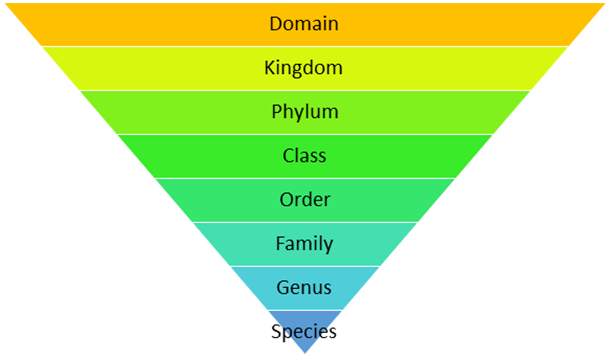

taxonomy and systematics; concept of species and taxonomical hierarchy.
- Books Name
- ACME SMART COACHING Biology Book
- Publication
- ACME SMART PUBLICATION
- Course
- CBSE Class 11
- Subject
- Biology
Taxonomy and Systematics
Taxonomy: The branch of science dealing with the study of principles and procedures of classification is called taxonomy. The term taxonomy was coined by A.P. de Candolle. Linnaeus is considered as Father of Taxonomy. Santapau is considered as Father of Indian Taxonomy. The fundamental elements of taxonomy are as follows :
- Characterisation and identification : It is the determination of the similarities of an organism with an already known organism, based upon specific characters.
- Nomenclature: It is the determination of correct name of an organism according to established universal rules.
- Classification: It is grouping of organisms into convenient categories on the basis of easily observable characters.
-
The classical taxonomy is based on observable morphological characters, however the modern taxonomy deals with several characters for the classification of organisms like
(a) External and internal structure alongwith the structure of cell.
(b) Development process.
(c) Ecological information of organisms
Systematics : The word "systematics" is derived from Latin word systema which means systematic arrangement of organisms. It was first used by Carolus Linnaeus. According to him, "systematics is the discipline of biology which deals with the kind and diversity of all organisms and the existing relationships amongst them."
Generally, the terms such as classification, systematics and taxonomy are used interchangeably but some taxonomists like Simpson (1961) relate them with a separate field. He defined systematics as
"The study of diversity of organisms and all their comparative and evolutionary relationships based on comparative anatomy, comparative ecology, comparative physiology and comparative biochemistry."
The main uses of systematics are as given below :
(i) It helps in providing knowledge of great diversity of animals and plants. It provides information regarding evolution which took place among plants and animals by knowing the distinction, relationship, habitat and habits. It thus, gives a vivid picture of entire organic diversity.
(ii) It helps in the identification of fossils which gives useful information about the phylogeny of organisms.
(iii) Newly discovered organisms can be identified through systematics.
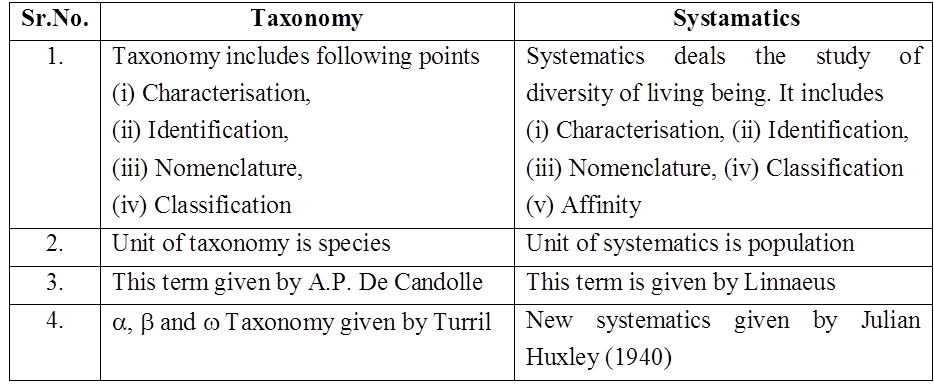
TAXONOMIC CATEGORIES
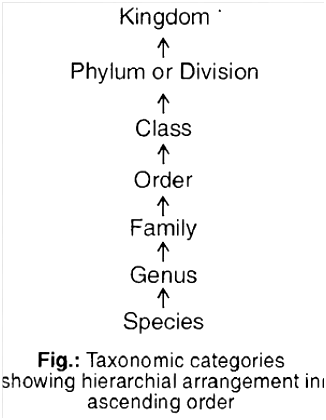
- Classification is not a single step process. It involves hierarchy of steps in which each step represents a rank or category.
- The category is a part of overall taxonomic arrangement. All categories together make taxonomic hierarchy.
- Each category is also termed as a unit of classification. It represents a rank and is commonly called as taxon.
- The taxon must be recognisable and order should belong to a category.
- Taxonomic hierarchy is a series of different ranks placed in ascending or descending order.
- It was Linnaeus who for the first time introduced five categories in the taxonomic hierarchy, viz., class, order, genus, species and variety.
- Later on three more categories, viz., kingdom, division or phylum and family were added.
- Variety was Species discarded to make a hierarchy of seven obligate categories.
- Taxonomic categories kingdom -division (in plants) or phylum (in animals) -class -order -family -genus -species. (descending order)
- Higher the category, higher is the number of organisms in it. Higher the category, fewer will be the number of common characters and greater is the difficulty of determining the relationship to other taxa at the same level. Hence, the problem of classification becomes more complex.
- Taxonomic categories and hierarchy can be illustrated by an example. Insects represent a group of organisms sharing common features like three pairs of jointed legs.
- It means insects are recognisable concrete objects which can be classified, and thus were given a rank or category.
- Similarly, mammals represent animals with external ears, body hairs, mammary glands etc. Dog, mammals, animals are all taxa but of different categories.
- Taxon dog, mammals and animals represent categories like species, class and kingdom respectively.
Species:
- Term given by John Ray. It is lowest category of classification. It is a group of closely related individuals with similar morphological, anatomical, biochemical and cytological characters.
- It is a group of naturally interbreeding population with the ability to produce fertile offsprings.
- Individuals of a species share common gene pool.
- It is reproductively isolated, thus genetically closed system.
e.g, Pisum sativum – Pea
Mangifera indica – Mango
Solanum tuberosum – Potato
Panthera leo – Lion
Homo sapiens – Human being
In these, sativum, indica, tuberosum, leo, sapiens represent the specific epithet, while Pisum, Mangifera, Solanum, Panthera and Homo represent genus.
Genus:
- Genus is a group of related species. Species has more characters in common in comparison to species of other genera.
- e.g., Potato, (Solanum tuberosum), makoi (S. nigrum) and brinjal (S. melongena) are three different species belonging to same genus Solanum.
- Lion, leopard and tiger with several common features belong to the same genus Panthera.
Family:
It is a group of related genera with still less number of similarities as compared to genus and species. Families are characterised on the basis of both vegetative and reproductive features of plants.
- For example, four related genera Solanum, Petunia, Datura and Atropa belong to the family Solanaceae. Genus Panthera and Felis (cat) are put together in family Felidae.
Order:
- It is a group of related families which exhibit a few similar characters. The similar characters are less in number as compared to different genera included in a family.
- For example, plant families like Convolvulaceae and Solanaceae are included in order Polymoniales mainly based on floral characters.
- In animals, order carnivora includes families like Felidae (cat) and Canidae (dog).
Class:
- It is a group of related orders.
- For example , plants order like Sapindales (mango) and Polymoniales are included in Class -Dicotyledonae, Order -Volvocales (Volvox) and Conjugales (Spirogyra) are included in Class -Chlorophyceae (green algae).In animals, order Primata (man, monkey) and Carnivora (cat, dog) are included in class -Mammalia.
Phylum/Division :
- It is a group of related classes.
- The phylum Chordata of animals contains not only the class mammalia but also aves (birds), reptilia (reptiles) amphibia (amphibians) and osteichthyes (fishes).
- In case of plants, classes with few similar characters like dicots and monocots constitute division -Angiospermae.
- The category phylum is used in animalia while division is used in plantae.
Kingdom:
- It is highest category in hierarchy with related phylums or divisions.
Kingdom animalia includes all animals belonging to different phyla. Kingdom Plantae includes all plants of various divisions.
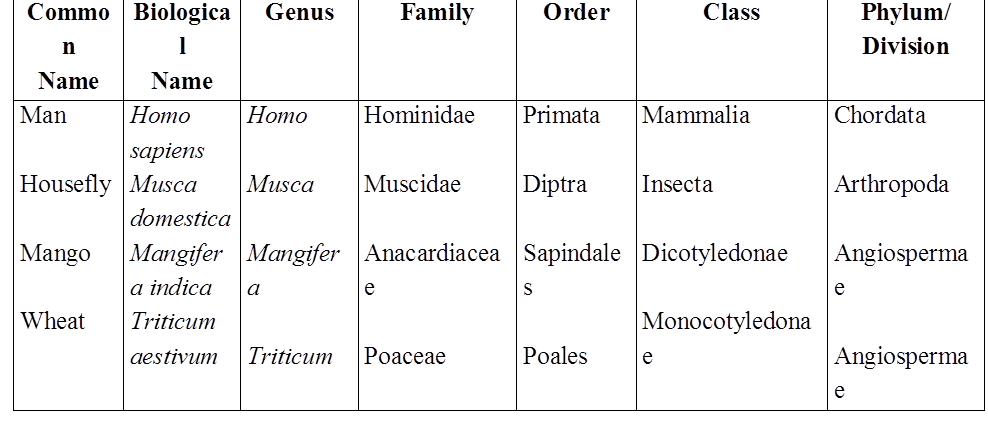
Concept of Species :
Biological concept of species (was given by Ernst Mayr) : Species is the fundamental unit of classification. A species is a group of organisms (i) which are closely related (structurally and functionally) sharing a common gene pool (ii) which can interbreed freely in nature and produce fertile offspring in a natural environment. This concept of species is based upon reproductive isolation and called biological concept.
Some important interspecific hybrids (exception of biological concept of species)
(i) Sterile Hybrid (under natural conditions)
Mule = Between male donkey and female horse (Mare)
Hinny = Between male horse (Stal'lion) and female donkey
(ii) Fertile Hybrid (under captive conditions)
Tigon = Between male tiger and female lion
Liger = Between male lion and female tiger
Types of Species :
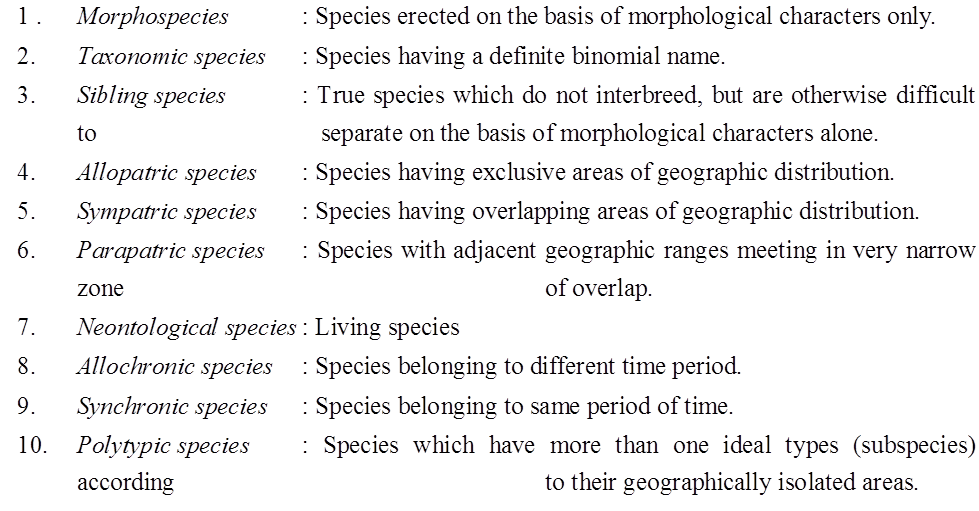
TAXONOMICAL AIDS
- The laboratory and field studies are required for identification of various species and their placement in taxonomical hierarchy.
- The information thus gathered about the species, needs to be stored for future use.
- The taxonomical aids developed by biologists have established certain procedures and techniques to store and preserve the information as well as the specimens
Binomial nomenclature.
- Books Name
- ACME SMART COACHING Biology Book
- Publication
- ACME SMART PUBLICATION
- Course
- CBSE Class 11
- Subject
- Biology
NOMENCLATURE
There is a need to standardize the naming of living organisms, such that a particular organism is known by same name all over the world. A variety of nomenclatural methods are described below :
1.Vernacular name: Names in local or common language are called vernacular names. So, many vernacular names exist for an organism in different languages. These may vary from place to place.
2.Scientific names: These names were based on definite rules and criteria. These are of following types :
(i) Polynomial nomenclature
(ii) Trinomial nomenclature [both given in concept builder]
(iii) Binomial system of nomenclature:
a.Swedish naturalist Carolus Linnaeus established binomial nomenclature though, it was first proposed by Casper Bauhin in his book PINAX.
b. In binomial nomenclature, the first word is a generic name and second word is a specific epithet like Mangifera indica Linn.
c. After end of biological name, the name of author is written in abbreviated form who gave the name of the organism.
d.Scientific names are in Latin, because Latin was the language of scholars at the time of Linnaeus, and no change is possible in the language because this language has no synonyms.
e.Linnaeus gave some principles of the binomial nomenclature in Philosophia Botanica.
f. The nomenclature was used first in Species Plantarum (1753), where names and description of 5900 species of plants were given.
g.He published Systema Naturae (1758), where 4326 species of animals were described.
A. International Code of Nomenclature
Scientific names have been standardised through some international agencies, viz., International Code of Botanical Nomenclature (ICBN, 1961) and International Code of Zoological Nomenclature (ICZN, 1964), International Code for Nomenclature of Bacteria (ICNB), International Code of Nomenclature for Cultivated Plants (ICNCP) and currently being developed is International Committee for the Taxonomy of Viruses (ICTV).
B. Rules for Binomial Nomenclature
ICBN and ICZN formulated certain rules and regulations for giving scientific names to all organisms. These rules are as follows :
- The valid name of an organism has two components, i.e., a generic name and a specific epithet. The generic name should begin with a capital letter and species name should begin with a small letter.
- Both the words in a biological name when handwritten are separately underlined or printed in italics to indicate their Latin origin.
- The name of the author should be written after the scientific name in Roman type with capital letter without any comma in between and is written in an abbreviated form, e.g., Homo sapiens Linn. is the complete scientific name for modern man. This shows that Linnaeus was the first scientist who named man as Homo sapiens.
- Scientific names should not contain less than three and more than twelve letters.
- Principle of priority: It is the most important of all the rules of ICBN. If first name given to the organism is valid (in terms of rules), that will be considered at the first preference. Any other valid name given after that will be considered as synonym. No names are recognised prior to those used by Linnaeus in 1758 in the 10th edition of Systema Naturae for animals and 1753 for plants.
- All the three words (generic name, species epithet and author citation) collectively form Binomial epithet.
- If a species name has two or more words in its name, a hyphen is put between these. Such names are compound specific names (e.g., Hibiscus rosa-sinensis).
zoological parks.
- Books Name
- ACME SMART COACHING Biology Book
- Publication
- ACME SMART PUBLICATION
- Course
- CBSE Class 11
- Subject
- Biology
Zoological Parks
- Zoos or zoological gardens (parks) are protected areas or enclosed space where live wild animals are kept, under human care. This enables us to learn their food habits and behaviour.
- Objectives are public exhibition to understand wild life, recreation, education, ex situ conservation and breeding of rare fauna.
- Largest zoo of the world is situated in Kruger (S. Africa).
- National Zoological Park (Delhi) is one of the finest zoo of Asia.
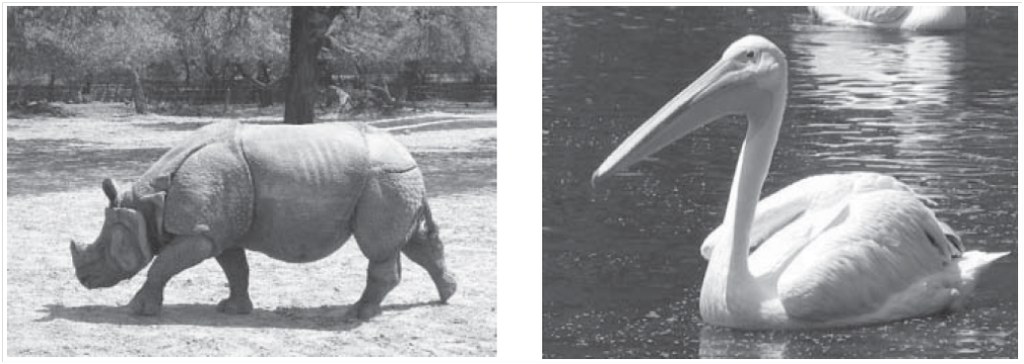
Herbaria.
- Books Name
- ACME SMART COACHING Biology Book
- Publication
- ACME SMART PUBLICATION
- Course
- CBSE Class 11
- Subject
- Biology
Herbarium (Dry Garden)
- It is defined as "a store house of collected plant specimens that are dried, pressed and preserved on sheets."
- These sheets are arranged in the sequence of an accepted classification system.
- These specimens, along with their description on herbarium sheets, become a store house or repository for future use. The herbarium sheet contains a label on the right-hand side at lower corner.
- Label provides information about date and place of collection, English, local and botanical names, family, collector's name etc.
- Herbaria also serve as quick referral systems in taxonomical studies.
Herbarium Sheet
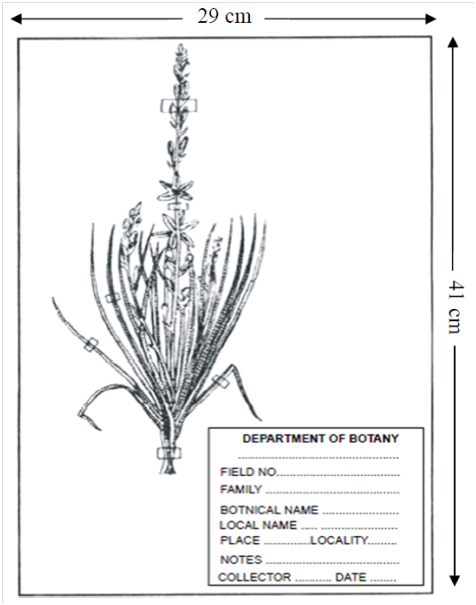

Functions of a Herbarium
The two primary functions of herbarium are accurate identification and alpha taxonomic research (based on gross morphology).
The secondary functions include closer interaction between the student of general systematics and the herbarium.
Other important functions of a herbarium are –
1.To preserve plant wealth including type material and palaeobotanical collections.
2.To carry out exchange and loan of preserved plant material for research, exhibitions etc.
A list of important herbaria of the world is given below along with their standard abbreviations and the approximate number of specimens they hold

TYPE SPECIMEN (HERBARIUM SHEET)
Type specimen (Herbarium Sheet) of newly discovered plant should be place in herbarium (Dry garden). Standered size of herbarium sheet is 11.5 × 16.5 inches.
Holotype - Herbarium sheet on which the first description of plant is based.
Isotype - Duplicate of holotype - In presence of holotype a second herbarium sheet prepared from the original plant is called isotype.
Paratype - Additional herbarium sheet used in the first description of plant is called paratype. It is prepared from some other plant of same species having some variations.
Lectotype - In case of holotype is lost, second herbarium sheet prepared from the original plant is called lectotype.
Neotype - In case of holotype and original plant is lost, then herbarium sheet prepared from some other plant of same species is called neotype.
Syntype - In case of holotype and original plant is lost then many herbarium sheet prepared from many plants of same species is called syntype.
Note : Nomenclature is invalid in absence of Herbarium sheet.
Botanical gardens.
- Books Name
- ACME SMART COACHING Biology Book
- Publication
- ACME SMART PUBLICATION
- Course
- CBSE Class 11
- Subject
- Biology
Botanical Gardens
- From the time of Theophrastus, gardens have contributed to the science of botany. But, there was an impetus to the botanical explorations only in the Post-Linnean period.
- In ancient Indian culture, cultivation of food and medicinal plants is known since 4000 to 2000 B.C. The 'Hanging Gardens of Babylon' are amongst the wonders of the ancient world.
- During the Middle Ages, from A.D. 600-1600, there was a lapse in learning and introduction of plants.
- In the seventeenth century, there was a revival in the interest and by eighteenth century, most of the famous Botanical Gardens known today had already been established.
The functions of a botanical garden are:
- Provide records of local flora for monographic work.
- Provide facilities for collections and identification of living plant material for biosystematic studies / references.
- Supply seeds and material for botanical investigations.
- Botanical gardens have an aesthetic appeal and attract a large number of visitors for observing general plant diversity.
- Provides means of ex-situ conservation strategies.
- There are about 525 botanical gardens in various countries, but only about 125 have documented collections of authenticated taxa.
6.The International Association of Botanical Gardens was established in 1962. This association has published the International Directory of Botanical Gardens (1983).
BOTANICAL GARDENS OF INDIA
- The Indian Botanical Garden, Kolkata, India: It was founded in 1787, by Lt.Col. Robert Kyd. It covers an area of 273 acres and contains collections of world's tropical plants.
- It is one of the greatest botanical gardens of the world and one of the first to be established in tropics.
- William Roxburgh, 'Father of Indian Botany' was its director from 1793 to 1813.
- It has the largest herbarium of east and is famous for the Great Banyan tree, Ficus benghalensis, which is two centuries old, the palm houses, nurseries and the Amazon lily, Victoria amazonica (Nymphaeaceae), the plant with the largest leaves.
It is now under control of BSI (Botanical Survey of India).
Other botanical gardens of India are -
Lloyd Botanical Garden – Darjeeling
National Botanical Garden – Lucknow
Lalbag Gardens – Bangalore
Saharanpur Botanical Garden – Saharanpur
Diversity in the Living World
- Books Name
- ACME SMART COACHING Biology Book
- Publication
- ACME SMART PUBLICATION
- Course
- CBSE Class 11
- Subject
- Biology
Diversity in the Living World
From a current estimation, approximately 1.7 million species have been scientifically named and classified. These include nearly 1.2 million animals and over 0.5 million species of plants.
Amongst animals, insects form the largest group, i.e., over 10,25,000 species. It is estimated that majority of species diversity is confined to tropical rain forests and huge diversity exist in under water reef formations in tropical oceans.
Existing living species are the outcome of about 3.5 billion years of evolutionary process on this earth. Nearly 15,000 new organisms are discovered every year.
A clearer understanding of this huge variety of organisms can be studied by dividing these into smaller groups or sub-groups (categories) and each group or sub-group comprising of organisms with more or less similar characters.
Method of placing organisms into groups or sub-groups depending upon extent of similarities and differences is called classification.
The division of organisms into different groups follows certain rules, that is why the term called taxonomy is used for classification of organisms following certain rules or principles.
Diversity in the Living World
Diversity in the Living World
Diversity in the world can be experienced everywhere on the earth. Each different kind of plant, animal, or organism that you see represents a species. The number of species that are known and described ranges from 1.71.7 to 1.81.8 million, which is referred to as biodiversity. Every individual is unique with respect to structure, body functions, genetic make-up, etc
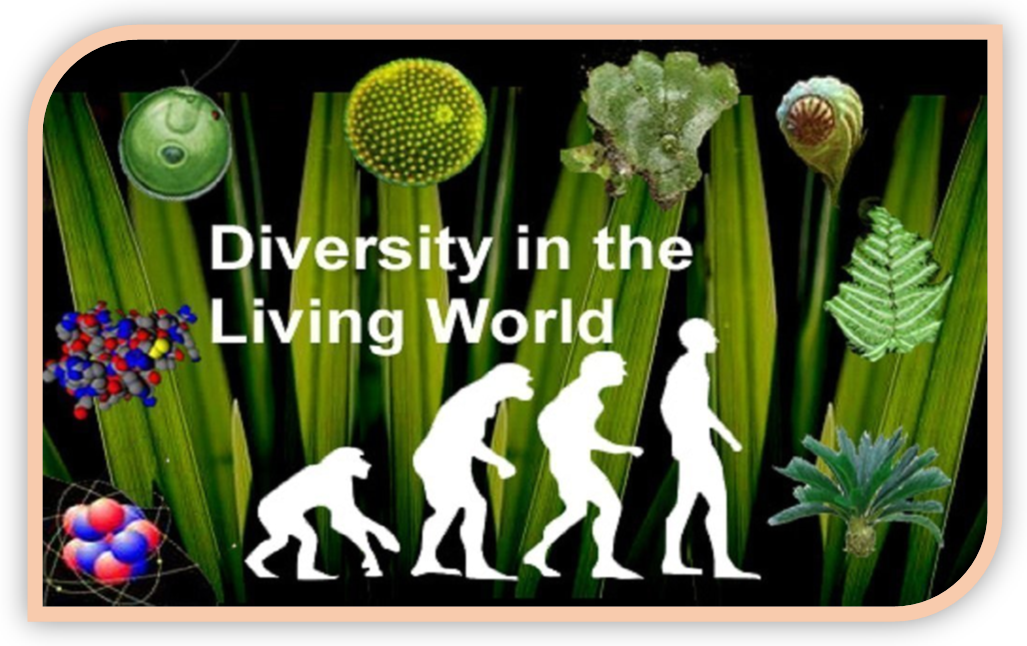
Living organisms inhabiting different habitats have different structural organs or functions developed according to the conditions of the habitat. The warm and humid regions of the earth have diverse organisms and thus are known as the region of mega biodiversity.
Terminology utilized as a part of classification includes Nomenclature, Classification, Taxonomy and Systematics.
The process of naming an organism is known as nomenclature. A principle and criterion were given for naming the organisms, by scientists known as International Code for Botanical nomenclature (ICBN). For animals, International Code of Zoological Nomenclature. This helps scientists from all over the world to interact with each other using the same name.
Each name consists of two parts the first part is the generic name and the second part is the name of the species. This is known as Binomial Nomenclature. This was given by a scientist known as Carolus Linnaeus.
Examples: Mangifera Indica (Mango); Homo sapiens (Man)
In this case, Mangifera and Homo are the generic names; indica and sapiens are specific epithets.
Rules of Nomenclature:
- Each biological name has two words-The principal word speaks about the genus and the second speaks to the specific epithet.
- The expressions of the name ought to be independently underlined when manually written and ought to be in italics when printed.
- The generic name ought to begin with a capital letter and the specific epithet ought to begin with a little letter.
- The names ought to be either Latin or Latinized.
Classification: It is the process of assigning creatures to particular groups or classes taking into account some defined characters. These classes are called Taxa (sing. taxon)
Taxonomy: It is the investigation of identification, nomenclature and arrangement of life forms taking into account outer and inside the structure with cell structure, advancement process and biological data.
systematics: It is the investigation of life forms with reference to identification, nomenclature, arrangement and evolutionary correspondence.
Diversity in the Living World
Diversity in the living world
The biological variety and variability of life on Earth are referred to as biodiversity. Looking around, one will see a wide range of living organisms, including potted plants, insects, birds, pets, and other animals and plants. Other species are invisible to the naked sight but are all around us. A species is represented by each different type of plant, animal, or organism you see. Between 1.7 and 1.8 million species have been identified and described. This refers to the diversity of species on the planet or the quantity and varieties of creatures that exist.
There are millions of plants and animals throughout the world that are known by their regional names. These regional names might differ from one location to the next, even within a country. When referring to organisms, such names can cause confusion. As confuse necessary to standardize the naming of living entities so that they are known by the same name all over the world. This is referred to as nomenclature.
This naming or nomenclature is only achievable if the organism is correctly characterized and we know to which organism the term refers. This is calledidentification.
Scientists have developed processes to assign a scientific name to each known organism in ordering the process. Scientific names for plants are determined by agreed-upon principles and criteria outlined in the International Code for Botanical Nomenclature (ICBN). Taxonomists have developed the International Code of Zoological Nomenclature (ICZN) for animals. Each creature has just one name thanks to the scientific names. Any organism's description should allow anyone (from all over the world) to come up with the same name. They also check to see if the name has been used for any other organism.
To give known creatures scientific names, biologists use broadly accepted rules. Each name is made up of two parts: a generic name and a specific epithet. Binomial nomenclature is a system for naming organismsconsisting of two parts. Carolus Linnaeus devised a naming system that is used by biologists all around the world. He is also known as the Father of Taxomy. This two-name approach was proven to be convenient.Mangiferaindica is the scientific name for the mango where, Mangifera denotes the genus, while indica denotes a specific species or epithet. The following are the universal rules of nomenclature:
1. Biological names are usually written in italics and written in Latin. Regardless of their origin, they are Latinized or derived from Latin.
2. In a biological name, the first component identifies the genus, whereas the second component denotes the specific epithet.
3. In handwriting, both words in a biological name are underlined or typed in italics to reflect their Latin origin.
4. The genus name begins with a capital letter, but the particular epithet begins with a tiny letter.
The author's name occurs after the specific epithet, i.e., the after the zoological name, and is shortened, e.g., Mangiferaindica Linn. It denotes that Linnaeus was the first to describe this species.
Classification is the procedure of grouping things into useful categories based on plainly observable characteristics. Plants and animals, as well as dogs, cats, and insects, are easily identifiable. These phrases link certain characteristics to the organisms in that group. When we talk about mammals,' we're talking about animals with external ears and body hair. As a result, terminology like "Dogs," "Cats," "Mammals," "Wheat," "Rice," "Plants," and "Animals," among others, are useful categories for studying creatures. Taxa is the scientific word for these classifications. A taxon can denote a variety of categories at various levels. Plants are classified as a taxon. 'Wheat' is a taxon as well. 'Animals,' 'Mammals,' and 'Dogs,' for example, are all taxa. As a result, the terms 'animals,"mammals,' and 'dogs' all refer to taxa at various levels.
As a result, all living species can be divided into different taxa based on their properties. Taxonomy is the term for this classifying procedure. The external and internal structure of organisms, as well as cell structure, development process, and ecological information, are essential and form the basis of modern taxonomic investigations. As a result, the fundamental stages of taxonomy are characterization, identification, categorization, and nomenclature. Humans, fora long, have been learning more about different types of organisms, particularly concerning their own Hence, the early classifications were based on the diverse utilities of organisms.
Humans have long been fascinated not only by diverse types of species and their diversity but also by the links that exist between them. The term "systematics" was coined to describe this field of study. The name "systematics" comes from the Latin word "systema," which means "an orderly arrangement of organisms." The title of Linnaeus' publication was SystemaNaturae. Identification, naming, and classification was later added to the scope of systematics. Systematics is the study of organisms' evolutionary relationships.
Taxonomic Categories
- Books Name
- ACME SMART COACHING Biology Book
- Publication
- ACME SMART PUBLICATION
- Course
- CBSE Class 11
- Subject
- Biology
TAXONOMIC CATEGORIES

Classification is not a single step process. It involves hierarchy of steps in which each step represents a rank or category.
The category is a part of overall taxonomic arrangement. All categories together make taxonomic hierarchy.
Each category is also termed as a unit of classification. It represents a rank and is commonly called as taxon.
The taxon must be recognisable and order should belong to a category.
Taxonomic hierarchy is a series of different ranks placed in ascending or descending order.
It was Linnaeus who for the first time introduced five categories in the taxonomic hierarchy, viz., class, order, genus, species and variety.
Later on three more categories, viz., kingdom, division or phylum and family were added.
Variety was Species discarded to make a hierarchy of seven obligate categories.
Taxonomic categories kingdom -division (in plants) or phylum (in animals) -class -order -family -genus -species. (descending order)
Higher the category, higher is the number of organisms in it. Higher the category, fewer will be the number of common characters and greater is the difficulty of determining the relationship to other taxa at the same level. Hence, the problem of classification becomes more complex.
Taxonomic categories and hierarchy can be illustrated by an example. Insects represent a group of organisms sharing common features like three pairs of jointed legs.
It means insects are recognisable concrete objects which can be classified, and thus were given a rank or category.
Similarly, mammals represent animals with external ears, body hairs, mammary glands etc. Dog, mammals, animals are all taxa but of different categories.
Taxon dog, mammals and animals represent categories like species, class and kingdom respectively.
Species:
Term given by John Ray. It is lowest category of classification. It is a group of closely related individuals with similar morphological, anatomical, biochemical and cytological characters.
It is a group of naturally interbreeding population with the ability to produce fertile offsprings.
Individuals of a species share common gene pool.
It is reproductively isolated, thus genetically closed system.
e.g, Pisum sativum – Pea
Mangifera indica – Mango
Solanum tuberosum – Potato
Panthera leo – Lion
Homo sapiens – Human being
In these, sativum, indica, tuberosum, leo, sapiens represent the specific epithet, while Pisum, Mangifera, Solanum, Panthera and Homo represent genus.
Genus:
Genus is a group of related species. Species has more characters in common in comparison to species of other genera.
e.g., Potato, (Solanum tuberosum), makoi (S. nigrum) and brinjal (S. melongena) are three different species belonging to same genus Solanum.
Lion, leopard and tiger with several common features belong to the same genus Panthera.
Family:
It is a group of related genera with still less number of similarities as compared to genus and species. Families are characterised on the basis of both vegetative and reproductive features of plants.
For example, four related genera Solanum, Petunia, Datura and Atropa belong to the family Solanaceae. Genus Panthera and Felis (cat) are put together in family Felidae.
Order:
It is a group of related families which exhibit a few similar characters. The similar characters are less in number as compared to different genera included in a family.
For example, plant families like Convolvulaceae and Solanaceae are included in order Polymoniales mainly based on floral characters.
In animals, order carnivora includes families like Felidae (cat) and Canidae (dog).
Class:
It is a group of related orders.
For example , plants order like Sapindales (mango) and Polymoniales are included in Class -Dicotyledonae, Order -Volvocales (Volvox) and Conjugales (Spirogyra) are included in Class -Chlorophyceae (green algae).In animals, order Primata (man, monkey) and Carnivora (cat, dog) are included in class -Mammalia.
Phylum/Division :
It is a group of related classes.
The phylum Chordata of animals contains not only the class mammalia but also aves (birds), reptilia (reptiles) amphibia (amphibians) and osteichthyes (fishes).
In case of plants, classes with few similar characters like dicots and monocots constitute division -Angiospermae.
The category phylum is used in animalia while division is used in plantae.
Kingdom:
It is highest category in hierarchy with related phylums or divisions.
Kingdom animalia includes all animals belonging to different phyla. Kingdom Plantae includes all plants of various divisions.

Concept of Species :
Biological concept of species (was given by Ernst Mayr) : Species is the fundamental unit of classification. A species is a group of organisms (i) which are closely related (structurally and functionally) sharing a common gene pool (ii) which can interbreed freely in nature and produce fertile offspring in a natural environment. This concept of species is based upon reproductive isolation and called biological concept.
Some important interspecific hybrids (exception of biological concept of species)
(i) Sterile Hybrid (under natural conditions)
Mule = Between male donkey and female horse (Mare)
Hinny = Between male horse (Stal'lion) and female donkey
(ii) Fertile Hybrid (under captive conditions)
Tigon = Between male tiger and female lion
Liger = Between male lion and female tiger
Types of Species :

Concept Builder
In accordance with International Code of Botanical Nomenclature, the names of different categories must end in the standard endings (suffixes) given below :
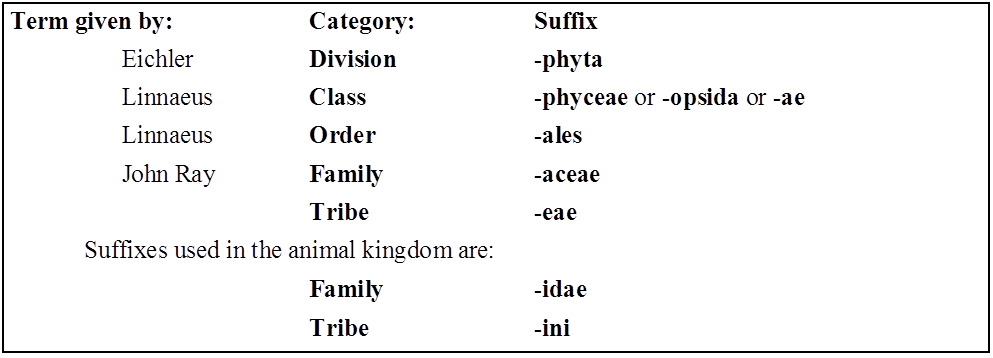
Tournefort gave the term genus and John Ray gave the term species
(b) Names of some families are changed according to ICBN rules for suffixes.
Old Name New Name
Palmae Arecaceae
Graminae Poaceae
Leguminosae Fabaceae
Compositae Asteraceae
Cruciferae Brassicaceae
Umbelliferae Apiaceae
Labiatae Lamiaceae
Guttiferae Clusiaceae
(c) Tribe is an intermediate category between sub-family and genus.
(d) In asexually reproducing organisms, physical resemblances and differences are used for delimiting species.
(e) Basic function of biological classification :
- (a) Recognition and description of species.
- (b) Grouping the species on the basis of similarities and relationship.
- (c) To establish evolutionary relationship amongst different organisms.
(f) The genera which have more than one specific epithets, are known as polytypic.
Lion – Panthera leo
Leopard – Panthera pardus
Tiger – Panthera tigris
(g) There are 7 obligate categories and about 21 intermediate categories. Prefixes: sub-and super-used for intermediate categories.
(h) Species name is given on the basis of some characters or habit, colour and distribution, e.g., niger (black), alba (white), tuberosum (tuber).
(i) Taxon is a group of real organisms which is assigned for any category. It is the unit of classification for any rank. Term taxon was introduced by ICBN in 1956 and defined by Mayr (1964).
(j) Category is an abstract term and represents only rank or level in a hierarchy and does not represent the living organisms. Example: Reptile is taxon but reptilia is category.
(k) Typological concept of Species
It was proposed by “Aristotle” and “Plato”. According to this concept, “There is a definite type or pattern of characters are present in the each species and all the members of species shows maximum resemblance with this pattern”. The species in which one fixed pattern of characters is present are called as monotypic species. e.g., Bacteria, Blue green algae if more than one type of pattern of characters are present. These are called “Polytypic species” or “Macrospecies”. e.g., Brassica oleracea Cauliflower, Cabbage, Knol-Knol.
Type of Polytypic Species :
Biotype : Members of same species inhabiting similar environment and having some genetic variations are known as biotypes. Variations found in these members are permanent. These members can not interbreed among themselves. e.g. Cauliflower, Cabbage, Knol-Khol are three biotypes of one species
Ecotypes : Members of same species inhabiting different environment and having some genetic variations are known as ecotypes. Variations are permanent. These members can interbreed among themselves but due to geographical barrier they can not interbreed.
e.g., Crow (Corvus splendense) found in different regions are ecotype of one species
Corvus splendense splendense - Indian crow
Corvus splendense insolense - Myanmar crow
Corvus splendense protegatus - Srilankan crow
Ecospecies : It contains one or more ecotype which although interfertile (capable of interbreeding), but do not produce viable offsprings due to some natural interruption (mountain, ocean etc).
Ecads or Ecophenes : Members of same species having some non genetic variation due to environment. These variations are temporary.
e.g.,

Taxonomic Categories
Taxonomic Categories
Classification is not a one-step procedure, but rather a series of stages, each representing a rank or category. The category is called a taxonomic category because it is a part of the larger taxonomic arrangement, and all categories combined make up the taxonomic hierarchy. Each category, also known as a classification unit, indicates a rank and is frequently referred to as a taxon (plural taxa). A taxonomic category is a category that is part of a taxonomic arrangement, and all categories combined make up the taxonomic hierarchy. Thus, organisms are divided into kingdoms, phyla or divisions, classes, orders, families, genera, and species.
Insects are a group of organisms with three pairs of jointed legs and other characteristics in common. It indicates that insects are recognizable concrete objects that can be categorized and so have a rank or category assigned to them. The categories are represented by groups of people. Rank is also indicated by category. Each rank, or taxon, is a classification unit. These taxonomic groups/categories are biological entities in their own right, not just morphological aggregations.
The establishment of common categories such as kingdom, phylum or division (for plants), class, order, family, genus, and species have resulted from taxonomic investigations of all known organisms. Species is the lowest level of classification for all organisms, including those in the plant and animal kingdoms. The knowledge of characteristics of an individual or group of organisms is required to categorize an organism into distinct categories. This aids in the identification of similarities and differences between individuals of the same species as well as individuals of different species.
Let us take a detailed look at different taxonomic categories:
(A)Species: A species is a group of individual beings that share fundamental characteristics. Based on morphological features, one species is separated from other closely related species. Mangiferaindica, Solanum tuberosum (potato), and Pantheraleo are just a few examples (lion). The first three words, Mangifera, Solanum, and Panthera, are genera and denote a higher level of taxon or category, while the first three words, indica, tuberosum, and leo, are specific epithets. Each genus may have one or more specific epithets that refer to various creatures that share morphological characteristics. Panthera, for example, has the specific epithet tigris, and Solanum comprises species such as nigrum and melongena. Humans are members of the species sapiens, which is part of the genus Homo.As a result, the scientific designation for a human being is Homo sapiens. Species is regarded as the least inclusive and highly specific category of the taxonomic hierarchy.
(B) Genus: A genus is a collection of related species that share more characteristics than those from other genera. Genera can be defined as groups of closely related species. Potato and brinjal, for example, are two separate species that both belong to the Solanum genus. Panthera species include the lion (Pantheraleo), leopard (Pantherapardus), and tiger (Pantheratigris), all of which share several characteristics. This genus is distinct from the Felis genus, which includes cats.
(C) Family:In comparison to genus and species, a family consists of a set of related genera with fewer similarities. In plants, vegetative and reproductive characteristics are used to classify them into families. Solanum, Petunia, and Datura are three separate genera of plants that belong to the Solanaceae family. The genus Panthera, which includes the lion, tiger, and leopard, is placed in the family Felidae with the genus Felis (cats). Similarly, if you compare and contrast the characteristics of a cat and a dog, you would notice some parallels and variances. Felidae and Canidae are the two different families that they belong to.
(D) Order:Species, genus, and family are all based on a set of comparable characteristics. The aggregates of characters are used to identify the order and other higher taxonomic groups. The group of families that have a few similar characteristics is called order, which is a higher category. When compared to the different genera in a family, there are fewer comparable characters. Plant groups such as Convolvulaceae and Solanaceae are classified as Polymoniales based on their floral characteristics. Carnivora is an animal order that includes families like Felidae and Canidae.
(E) Class: A class is a taxonomic rank (a taxon) that contains species with similar characteristics; it is further divided into one or more orders. A class is a major taxonomic rank below the phylum (or division) and above the order in the biological categorization of life. This category includes orders that are related. Order Primata, which includes monkeys, gorillas, and gibbons, is placed in class Mammalia alongside order Carnivora, which includes tigers, cats, and dogs. Other orders also exist in the Mammalia class.
(F) Phylum/Division:A phylum is a classification or taxonomic rank that falls between kingdom and class. The Phylum is the next higher classification, which includes animals such as fish, amphibians, reptiles, birds, and mammals. All of these are classified as members of the phylum Chordata because they share characteristics such as the presence of a notochord and a dorsal hollow neural system. Classes with a few comparable features in plants are given to a higher category called Division.
In biological classification, the division is a taxonomic rank that is employed differently in zoology and botany. The division is a level similar to a phylum in botany and mycology. The term division is used in zoology to refer to an optional rank that is subordinate to the infraclass and superordinate to the cohort.
(G) Kingdom:In the classification system of animals, all animals belonging to distinct phyla are placed in the top category, Kingdom Animalia. The Kingdom Plantae, on the other hand, is unique in that it includes all plants of diverse divisions. These two groups are today referred to as the animal and plant kingdoms.
(H) Domain:A domain is the largest of all groupings in the classification of life in biology. At this level, the Archaea domain, Bacteria domain, and Eukarya domain are the three agreed-upon categories. The domain is considered to be the most inclusive category of the hierarchy.
The amount of shared features decreases as we progress from species to kingdom. The lower the taxon, the more features the members of the taxon share. The more difficult it is to determine a taxon's relationship to other taxa at the same level, the higher the category. As a result, the classification problem gets more complicated. Therefore, the taxonomists have also created sub-categories in the hierarchy to make the placement of distinct taxa more sound and scientific.
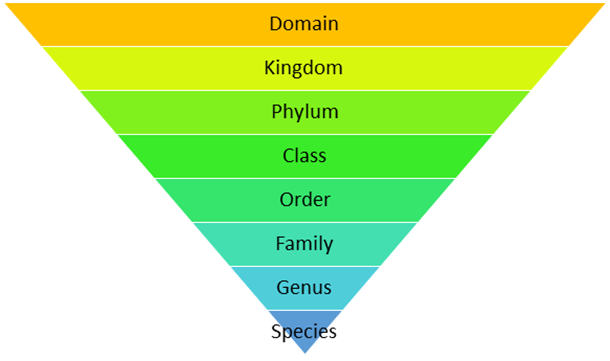

Taxonomic Categories
Taxonomy
Taxonomy Definition
Taxonomy is the branch of biology that classifies all living things. It was developed by the Swedish botanist Carolus Linnaeus, who lived during the 18th Century, and his system of classification is still used today. Linnaeus invented binomial nomenclature, the system of giving each type of organism a genus and species name. The Father of taxonomy was Carolus Linnaeus. He also developed a classification system called the taxonomic hierarchy, which today has eight ranks from general to specific: domain, kingdom, phylum, class, order, family, genus, and species.
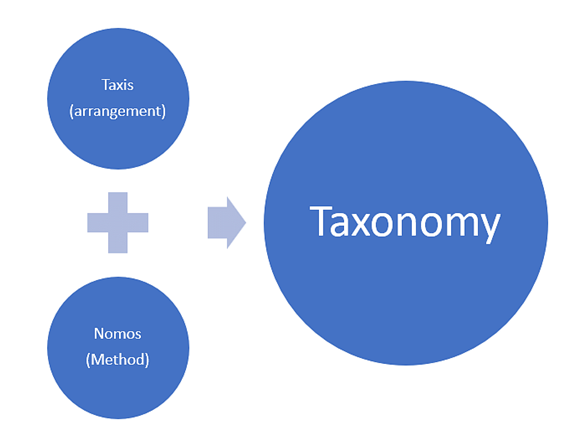
The Taxonomic Hierarchy
A taxon (plural: taxa) is a group of organisms that are classified as a unit. This can be specific or general. The hierarchy has two categories i.e., obligate and intermediate. Obligate is the one that is followed strictly and ranges from kingdom to species. Intermediate is not observed strictly and they. Also, they are added to the obligate lists like subdivision, superfamily, superclass, suborder, subspecies etc.
The following is a brief description of the taxonomic ranks of the taxonomic hierarchy.
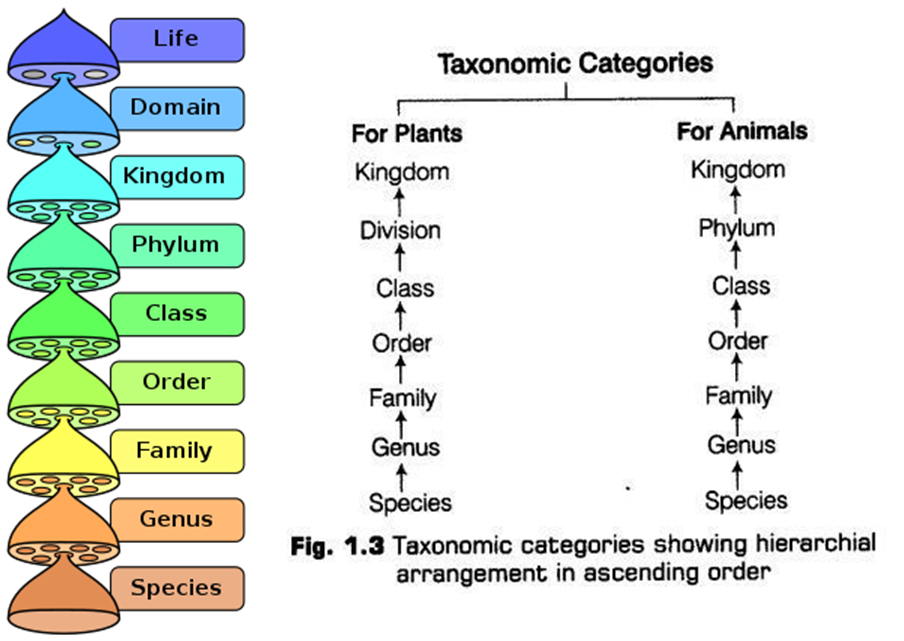
Domain
A domain is the highest (most general) rank of organisms. Linnaeus did invent some of the taxonomic ranks, but he did not invent the domain rank, which is relatively new. The term domain wasn’t used until 1990, over 250 years after Linnaeus developed his classification system in 1735.
The three-domain system of Carl Woese, introduced in 1990, with top-level groupings of Archaea, Bacteria, and Eukaryota domains.
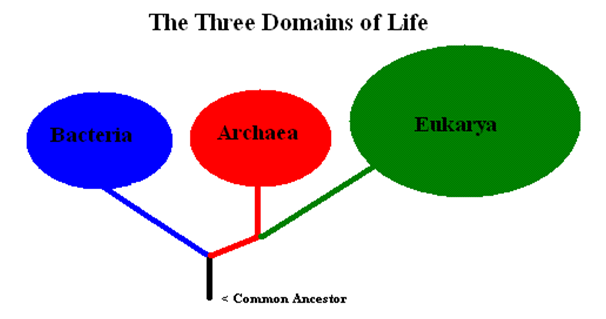
Kingdom
Before domains were introduced, the kingdom was the highest taxonomic rank. In the past, the different kingdoms were Animalia, Plantae, Fungi, Protista, Archaea, and Bacteria (Archaea and Bacteria were sometimes grouped into one kingdom, Monera)
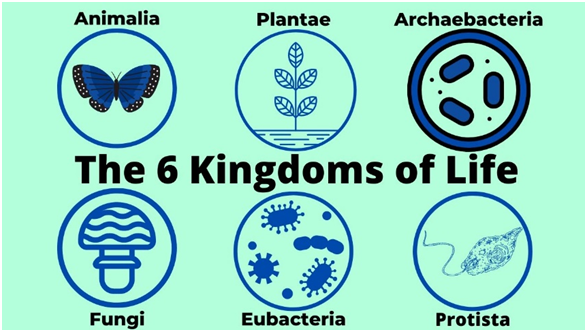
Phylum
Phylum (plural: phyla) is the next rank after kingdom; it is more specific than kingdom but less specific than class. There are 35 phyla in the kingdom Animalia, including Chordata (all organisms with a dorsal nerve cord), Porifera (sponges), and Arthropoda (arthropods).
Class
Class was the most general rank proposed by Linnaeus; phyla were not introduced until the 19th Century. There are 108 different classes in the kingdom Animalia, including Mammalia (mammals), Aves (birds), and Reptilia (reptiles), among many others.
Order
Order is more specific than class. Some of Linnaeus’ orders are still used today, such as Lepidoptera (the order of butterflies and moths). There are between 19-26 orders of Mammalia, depending on how organisms are classified—sources differ.
Genus
Genus (plural: genera) is even more specific than family. It is the first part of an organism’s scientific name using binomial nomenclature; the second part is the species name. An organism’s scientific name is always italicized, and the genus name is capitalized while the species name is not. Genus and species are the only taxonomic ranks that are italicized. The scientific name for humans is Homo sapiens. Homo is the genus name, while sapiens is the species name.
Species
Species are the most specific major taxonomic rank; species are sometimes divided into subspecies, but not all species have multiple forms that are different enough to be called subspecies. There are an estimated 8.7 million different species of organisms on Earth, While each genus name is unique, the same species names can be used for different organisms. For example, Ursus americanus is the American black bear, while Bufo americanus is the American toad.
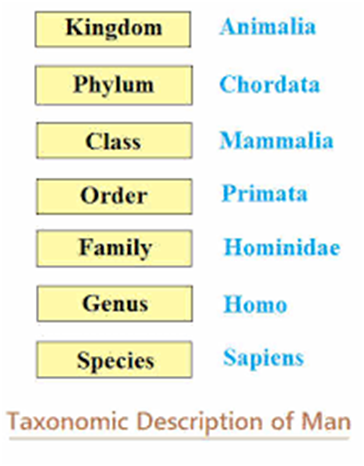
Taxonomical Aids
- Books Name
- ACME SMART COACHING Biology Book
- Publication
- ACME SMART PUBLICATION
- Course
- CBSE Class 11
- Subject
- Biology
TAXONOMICAL AIDS
The laboratory and field studies are required for identification of various species and their placement in taxonomical hierarchy.
The information thus gathered about the species, needs to be stored for future use.
The taxonomical aids developed by biologists have established certain procedures and techniques to store and preserve the information as well as the specimens.
1. Botanical Gardens
From the time of Theophrastus, gardens have contributed to the science of botany. But, there was an impetus to the botanical explorations only in the Post-Linnean period.
In ancient Indian culture, cultivation of food and medicinal plants is known since 4000 to 2000 B.C. The 'Hanging Gardens of Babylon' are amongst the wonders of the ancient world.
During the Middle Ages, from A.D. 600-1600, there was a lapse in learning and introduction of plants.
In the seventeenth century, there was a revival in the interest and by eighteenth century, most of the famous Botanical Gardens known today had already been established.
The functions of a botanical garden are:
1. Provide records of local flora for monographic work.
2. Provide facilities for collections and identification of living plant material for biosystematic studies / references.
3. Supply seeds and material for botanical investigations.
4. Botanical gardens have an aesthetic appeal and attract a large number of visitors for observing general plant diversity.
5. Provides means of ex-situ conservation strategies.
There are about 525 botanical gardens in various countries, but only about 125 have documented collections of authenticated taxa.
6. The International Association of Botanical Gardens was established in 1962. This association has published the International Directory of Botanical Gardens (1983).
Concept Builder
Some of the important Botanical Gardens are listed below :
1. Royal Botanical Garden, Kew, England : It was founded in 1759 by William Alton, but was officially opened in 1841 and was called the Botanical Capital of the World. Sir J.D. Hooker was one of its directors. It is famous for its Alpine house, Rose Garden, Green house, Temperature house, Bamboo garden and Lily pond. It is associated with Jodrell laboratory of experimental taxonomy. It is spread in 200 acres. It is famous for collection of Acacias, Acer, Rhus, Citrus, Rosa, Prunus, Magnolia. It has Chelsa Physic Garden for horticulturists. Kew
2. Orto Botanico (Padua Gardens), Italy: It is said to be the first botanical garden. It is famous for collections of grasses, Alliums, Irids, Paeonias, succulents and hydrophytes.
3. Pisa, Italy: Almost as old as Padua Gardens, it was the first to introduce palaeontological practises; for the study of plants fossils. It is known for trees like Magnolia grandiflora, Liriodendron tulipifera etc. Caesalpino and John Ray have been associated with this garden.
4. Villa Taranto, Italy: It is the most beautiful garden of Italy and important from the horticultural study point of view.
5. Main Botanical Garden, Moscow: Largest Botanical Garden, spread over an area of 900 acres.
BOTANICAL GARDENS OF INDIA
The Indian Botanical Garden, Kolkata, India: It was founded in 1787, by Lt.Col. Robert Kyd. It covers an area of 273 acres and contains collections of world's tropical plants.
It is one of the greatest botanical gardens of the world and one of the first to be established in tropics.
William Roxburgh, 'Father of Indian Botany' was its director from 1793 to 1813.
It has the largest herbarium of east and is famous for the Great Banyan tree, Ficus benghalensis, which is two centuries old, the palm houses, nurseries and the Amazon lily, Victoria amazonica (Nymphaeaceae), the plant with the largest leaves.
It is now under control of BSI (Botanical Survey of India).
Other botanical gardens of India are -
Lloyd Botanical Garden – Darjeeling
National Botanical Garden – Lucknow
Lalbag Gardens – Bangalore
Saharanpur Botanical Gardens – Saharanpur
Herbarium (Dry Garden)
It is defined as "a store house of collected plant specimens that are dried, pressed and preserved on sheets."
These sheets are arranged in the sequence of an accepted classification system.
These specimens, along with their description on herbarium sheets, become a store house or repository for future use. The herbarium sheet contains a label on the right-hand side at lower corner.
Label provides information about date and place of collection, English, local and botanical names, family, collector's name etc.
Herbaria also serve as quick referral systems in taxonomical studies.
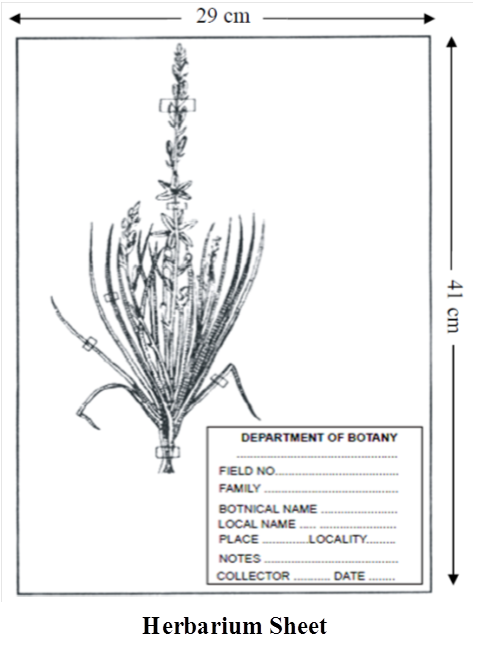

Concept Builder
Herbarium Technique
The herbarium technique involves the following steps:
- (a) Collection
- (b) Drying
- (c) Poisoning
- (d) Mounting
- (e) Stitching
- (f) Labelling
- (g) Deposition
(a) Collection: Collection of plant material is done with an aesthetic sense and scientific mind.
The material should be perfect and complete for determination, i.e., must have fully grown
leaves, complete inflorescence etc.
Woody elements are well represented by flowering twigs with 30-40 cm in lengths, while
herbaceous plants are collected alongwith underground parts.
Diseased plants, infected twigs should be avoided.
The collections are kept inside metallic vasculum or polythene bags.
(b) Drying: The plant collections are pressed in ordinary newspaper folders, avoiding overlapping. The folders, in turn, are pressed in a field press. The moistened folders are changed frequently to avoid blackening and decay of plant material.
(c) Poisoning: The specimens are poisoned to keep away the microbes. When the specimens are partially dehydrated, they are poisoned by using chemicals like 0.1% of corrosive, sublimate (HgCl2).
(d-f) Mounting, Stitching and Labelling : Dried specimens are glued and stitched on herbarium sheets made up of thick card sheets cut to the required size. The international size of the herbarium sheet is 41× 29 cm (16 ×11 inches) . The field data is entered on label on the right hand side lower corner of the herbarium sheet. Size of label is commonly 7 × 12cm. The small paper envelopes called fragment packets are often attached to the herbarium sheet to hold seeds, extra flowers or loose plant parts.
(g) Deposition: Arrangement of specimen, according to accepted classification, is called deposition. In India, herbaria are arranged according to Bentham and Hooker system of classification.
The specimens so preserved are sprayed with repellents or disinfectants such as DDT powder, copper sulphate solution at intervals of 4 to 6 months to keep off small insect pests such as silver fish.
Functions of a Herbarium
The two primary functions of herbarium are accurate identification and alpha taxonomic research (based on gross morphology).
The secondary functions include closer interaction between the student of general systematics and the herbarium.
Other important functions of a herbarium are
1. To preserve plant wealth including type material and palaeobotanical collections.
2. To carry out exchange and loan of preserved plant material for research, exhibitions etc.
A list of important herbaria of the world is given below along with their standard abbreviations and the approximate number of specimens they hold
1.Royal Botanical Gardens, Kew (K) over 6,000,000
4. Central National Herbarium, Calcutta (CAL) 2,000,000
TYPE SPECIMEN (HERBARIUM SHEET)
Type specimen (Herbarium Sheet) of newly discovered plant should be place in herbarium (Dry garden). Standered size of herbarium sheet is 11.5 × 16.5 inches.
Holotype - Herbarium sheet on which the first description of plant is based.
Isotype - Duplicate of holotype - In presence of holotype a second herbarium sheet prepared from the original plant is called isotype.
Paratype - Additional herbarium sheet used in the first description of plant is called paratype. It is prepared from some other plant of same species having some variations.
Lectotype - In case of holotype is lost, second herbarium sheet prepared from the original plant is called lectotype.
Neotype - In case of holotype and original plant is lost, then herbarium sheet prepared from some other plant of same species is called neotype.
Syntype - In case of holotype and original plant is lost then many herbarium sheet prepared from many plants of same species is called syntype.
Note : Nomenclature is invalid in absence of Herbarium sheet.
3. Keys [Given by John Ray]
The scheme for identification of plants and animals based upon similarities and dissimilarities is known as a key. It is based on the set of contrasting characters known as couplet, each character of couplet is called as lead. Separate taxonomic keys are required for each taxonomic category. Keys are generally analytical in nature and are of two types (1) Indented key (2) Bracketed key –
1. Indented Key: It has a sequence of choice between two or more statements of characters of species. These require great taxonomic skills to prepare, so are generally less followed.
2 Bracketed Key: In the Bracketed key the pairs of contrasting statements are used for identification. The bracketed number on the right side indicates the next choice of paired contrasting statements. These are most popular keys.
4. Zoological Parks
Zoos or zoological gardens (parks) are protected areas or enclosed space where live wild animals are kept, under human care. This enables us to learn their food habits and behaviour.
Objectives are public exhibition to understand wild life, recreation, education, ex situ conservation and breeding of rare fauna.
Largest zoo of the world is situated in Kruger (S. Africa).
National Zoological Park (Delhi) is one of the finest zoo of Asia.
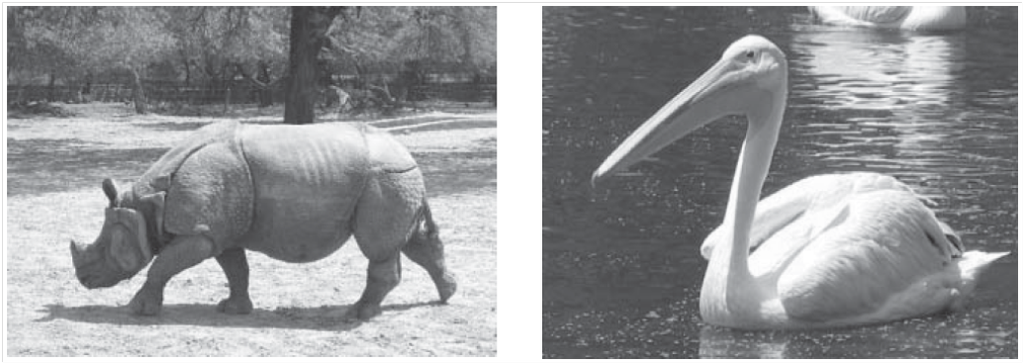
5. Museums
These have collections of preserved plants and animals for study and reference.
Specimens are preserved in jars or containers in preservative solution.
Plant and animal specimens may also be preserved as dry specimens.
Insects are preserved in insect boxes after collecting, killing and pinning.
Larger animals are usually stuffed and preserved.
These often have collections of skeletons of animals too.
Museums are prepared to preserve algae, fungi, mosses, ferns and organs of gymnosperms since they cannot be kept in herbaria. These differs from parks because no living object is displayed in museums.
Some important Museums:
(i) Natural History Museum, London (England)
(ii) United States National Museum, Washington
(iii) National Museum of Natural History (NMNH), Delhi
(iv) Prince of Wales Museum, Mumbai etc.
Comperative Study of Botanical Garden, Herbarium and Museum :
6.Flora, Manuals, Monographs and Catalogues
Flora: Contains the actual account of habitat and distribution of plants of a given area. These provide the index to the plant species found in a particular area.
Some important flora are given below:
(i) Flora of British India by J.D. Hooker.
(ii) Flora of Delhi by J.K. Maheshwari.
(iii) Flora Indica by William Roxburgh.
(iv) Flora Simlensis by H. Collet
Manuals: The complete listing and description of the plants growing in a particular area.
e.g., Manual of Cultivated Plants by L.H. Bailey
Monographs: Contain information on anyone taxon.
e.g., The Genus Pinus by N.T. Mirov
Catalogues: This includes the alphabetical arrangements of species describing their features.
Concept Builder
1. Ex-situ / Off-site conservation strategies for organisms includes Botanical gardens and Zoological parks.
2. Succulent plants or those plants which are unsuitable for pressing and drying techniques, are fixed in suitable liquid preservative like 2.5% solution of formaldehyde, glacial acetic acid and ethyl alcohol [FAA].
3. Herbarium technique was first introduced by Caesalpino et. al.
4. Botanical gardens of world have 15% or 35,000 plants species of the world flora.
Tapiary -Beautifying areas
Bonsai trees -Dwarf trees are grown,in pots
5. According to WZCS (World Zoo Conservation Strategies), zoological parks are meant to conserve the species that are particularly endangered in their natural environment. India has about 200 zoological parks.
SUMMARY
1. The living world is rich in variety. Millions of plants and animals have been identified and described but a large number still remains unknown.
2. The very range of organisms in terms of size, colour, habitat, physiological and morphological features make us seek the defining characteristics of living organisms.
3. In order to facilitate the study of kinds and diversity of organisms, biologists have evolved certain rules and principles for identification, nomenclature and classification of organisms.
4. The branch of science dealing with these aspects is referred to as taxonomy.
5. The taxonomic studies of various species of plants and animals are useful in agriculture, forestry, industry and in general for knowing our bio-resources and their diversity.
6. The basics of taxonomy like identification, naming and classification of organisms are universally evolved under international codes.
7. Based on the resemblances and distinct differences, each organism is identified and assigned a correct scientific/biological name comprising two words as per the binomial system of nomenclature.
8. An organism represents/occupies a place or position in the system of classification. There are . many categories/ranks and are generally referred to as taxonomic categories or taxa. All the categories constitute a taxonomic hierarchy.
9. The basis of modern taxonomic studies is : External and internal structure, along with the structure of cell, development process and ecological information of organisms
10. Taxonomists have developed a variety of taxonomic aids to facilitate identification, naming and classification of organisms. These studies are carried out from the actual specimens which are collected from the field and preserved as referrals in the form of herbaria, museums and in botanical gardens and zoological parks. It requires special techniques for collection and preservation of specimens in herbaria and museums.
11. Live specimens, on the other hand, of plants and animals, are found in botanical gardens or in zoological parks.
12. Taxonomists also prepare and disseminate information through manuals and monographs for further taxonomic studies.
13. Taxonomic keys are tools that help in identification based on characteristics.
Taxonomical Aids
Taxonomic Aids
Taxonomic studies of various plant, animal, and other organism species are useful in agriculture, forestry, and industry, and they aid in our understanding of biodiversity. These studies necessitate accurate organism taxonomy and identification. Identifying organisms necessitates extensive laboratory and field research. Taxonomic aids are collections of samples or preserved species that aid in the extended investigation for taxonomic hierarchy identification. The primary source of taxonomic studies is the collection of genuine specimens of plant and animal species. These are also necessary for systematics training and are crucial to studies. It's used to classify organisms, and the data acquired is saved alongside the specimens. In some situations, the specimen is saved for further research. Some popular taxonomic aids are discussed below
(I) Herbarium: A herbarium is a reference collection of properly selected and dried plants that are connected to standard-sized paper sheets and filed systematically so that they can be quickly found for study. It's a repository for plant specimens that have been collected, dried, pressed, and preserved on sheets. These sheets are organized according to a widely accepted classification scheme. These specimens, coupled with their descriptions on herbarium sheets, form a repository or storehouse for future use. A label on the herbarium sheets provides information such as the date and location of collection, English, local, and botanical names, family, and collector's name, among other things. In taxonomic investigations, herbaria also function as rapid referral systems.
The Museum of Natural History in Paris, The Royal Botanic Gardens in Kew, England, The New York Botanical Garden, and The Komarov Botanical Institute in St. Petersburg, Russia, have some of the world's largest herbaria, each having 7 to 9.5 million specimens.



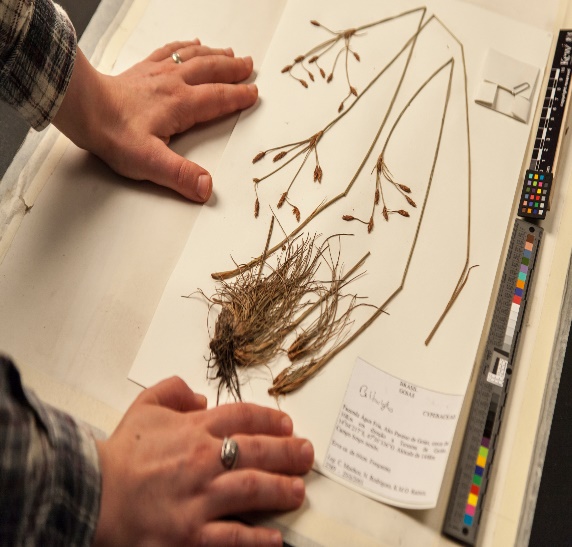
Figure 3: Different stages of herbarium preparation.
(II) Botanical Gardens:
For reference, these specialty gardens have collections of living plants. Plant species are planted in these gardens for identification, and each plant is labeled with its botanical/scientific name as well as its family. Botanical gardens commit their resources to plant research and conservation, as well as public awareness of the world's plant diversity. Royal Botanical Garden, Kew (England), Indian Botanical Garden, Howrah (India), and National Botanical Research Institute, Lucknow are all well-known botanical gardens.
(III) Museum:
A museum is a building where historical, artistic, or scientific objects are displayed, maintained, or researched. Modern museums are designed to collect, preserve, interpret, and show objects of aesthetic, cultural, or scientific significance for public study and education. Biological museums are most commonly found at educational institutions like schools and colleges. For study and reference, museums have collections of preserved plant and animal specimens. Preservative solutions are used to preserve specimens in containers or jars. Dry specimens of plants and animals can also be preserved. After capturing, killing, and pinning insects, they are kept in insect boxes. Stuffed and preserved larger creatures, such as birds and mammals, are common. Animal skeletons are frequently shown in museums.With 19 museums and galleries, the National Zoological Park, and many examination stations, the Smithsonian is the world's largest exploration and museum complex. The company's headquarters are in Washington, D.C.
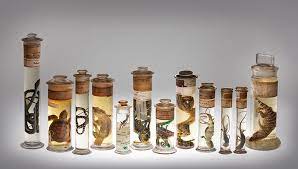
(IV) Zoological Parks:
Zoological parks are protected areas where animals are kept under human supervision and cared for. In zoological parks, many endangered species that are on the verge of extinction are rescued. These are facilities where wild animals are housed in safe conditions under human supervision so that we can learn about their eating habits, behavior, etc. Animals at zoos are kept in settings that are as close to their natural habitats as possible. These parks also contribute to the preservation of the natural balance by increasing the percentage of rainfall. They play a critical role in the conservation of animals. There are a total of 164 zoological parks in India. The Arignar Anna Zoological Park in Chennai is India's largest zoological park covering about 1300 acres with rare species of flora and fauna.
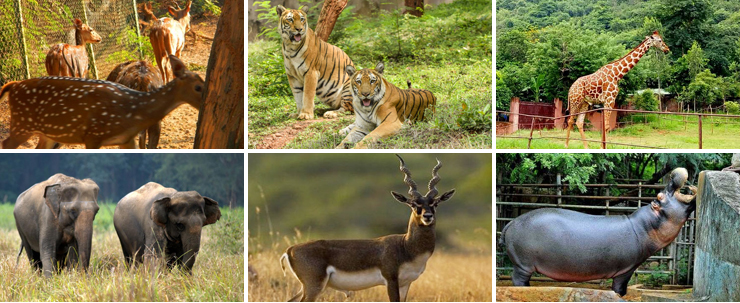
(V) Key:
Keys are used foridentifying and classifying various plants and animals based on their similarities and variances in characteristics. As a result, only one is accepted while the other is rejected. A lead is a name given to each assertion in the key. For identification purposes, separate taxonomic keys are necessary for each taxonomic group such as family, genus, and species. The majority of keys are analytical these are used to distinguish between classes, orders, families, genera, and species. It is split into pairs of characters that are either present or absent.
Other methods of recording descriptions include flora, manuals, monographs, and catalogs. They also assist with proper identification. Flora includes a detailed description of a certain area's habitat and plant distribution. These provide an index to the plant species that can be found in a certain area. A Catalogue is a comprehensive list, pamphlet, or register that contains a collection of traits and their variants found in diverse taxa.Manuals are important for identifying the names of species that can be found in a given area. Monographs are documents that focus on a single taxon.
Taxonomical Aids
Taxonomic Aids: Taxonomic studies of animals, plants, microorganisms and other species are highly useful in the field of forestry, industry, agriculture and the study of biodiversity. Hence, the organism should be identified, and classified and information about the organism should be stored for future studies and references. This storehouse of information and specimens that helps in taxonomic studies are called Taxonomic Aids.
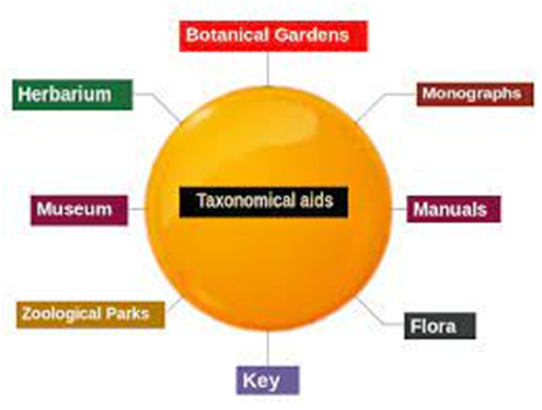
Herbarium: A herbarium is the storehouse of plant specimens.
It is a collection of dried, pressed, plant specimens that are arranged systematically according to a universally accepted system of classification. The Bentham and Hooker system is followed in most of Herbaria. The sheets on which the specimens are mounted are called Herbarium sheets
The total number of plant specimens are about 6.56.5 million.
Another Botanical Herbarium called Central National Herbarium is at Indian Botanical Garden, Howrah, Kolkata.
Some of the other examples are as follows:
a. National Botanical Garden, Lucknow
b. Lalbagh Botanical Garden, Bangalore, Karnataka
c. Government Botanical Garden, Ooty
d. Tropical Botanical Garden and Research Institute, Trivandrum, Kerala.
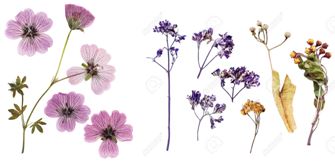
Botanical Garden: Botanical gardens are the place where varieties of plants collected from different places of the world are grown together in a protected environment. It may consist, of many rare, elite, exotic species. It shows rich biodiversity and plays an important role in germplasm conservation. In the Botanical Garden, all plants carry identification plates, having a common name, botanical name and the name of the family that belongs

Museum: It is the collection of preserved plants and animal specimens for study and reference. Specimens are preserved in jars using preservative solutions of alcohol and formalin. Only those plants that cannot be kept in the herbarium are preserved. Some of the specimens include algae, fungi, mosses, ferns, succulents, fruits, etc. Even fishes, reptiles, amphibians, etc., are stored. Large animals are preserved in skeleton forms. Insects are dried out and mounted over pins inside the insect boxes. Others are preserved as dry specimens in the Biological Museum.
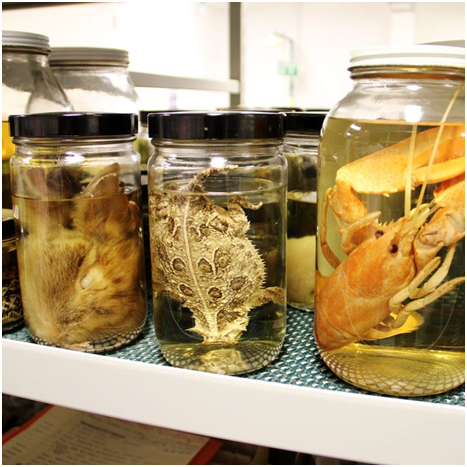
Zoological Park: Zoological Park is an enclosed area where wild animals are kept in an open, natural, but protected environment under human care. Zoological parks are the best places to study the behavior and food habitats of wild animals. Zoological parks help in conserving endangered animals and their multiplication through captive breeding. In India, there are around 200200 Zoological parks.
Zoological Parks are also important spots for children, students and the public to see wild animals
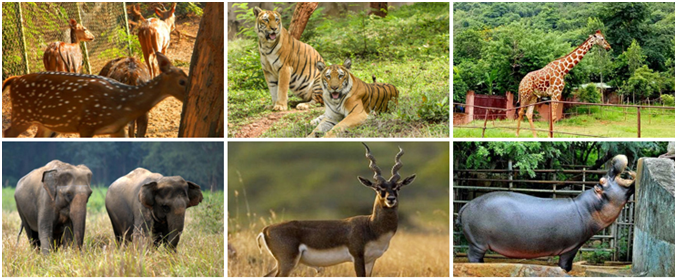

 AACHARYA KOTA CLASSES
AACHARYA KOTA CLASSES
